The expression seventh son of a seventh son, while not original to them, was popularised and brought to wider attention by the hugely successful and well known hard rock/metal band, Iron Maiden. It was both a song and title of an acclaimed seventh album and considered by many fans as one of their best loved albums alongside classics, The Number of the Beast, Piece of Mind and Powerslave. One wonders why the song is listed as track number five out of eight and wasn’t placed at number seven?
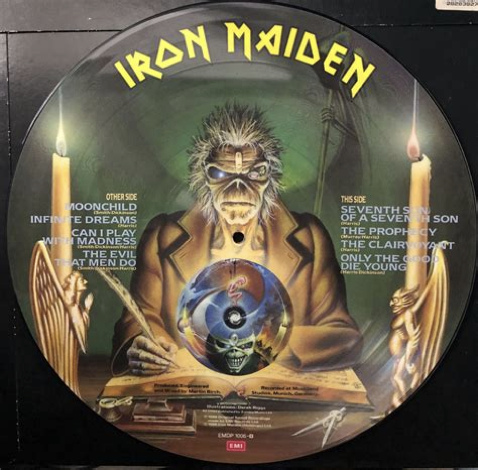
On a personal note, the inspiration for this article came from a question asked of me: “Who are some famous seventh sons, specifically the seventh son of the seventh son?” As this is a topic I have thought about during my research on the Israelite tribes, I was curious to discover more.
Online comment: “Yes, there have been documented instances of men being the seventh son of a seventh son. In some cultures and folklore, being the seventh son of a seventh son is believed to bestow special powers or abilities. This belief is particularly strong in Irish and Scottish folklore, where the seventh son of a seventh son is thought to have healing powers or be a natural-born healer. While there is no scientific evidence to support these beliefs, the idea has been a recurring theme in literature and folklore.”
We shall return to the subject introduced in the third sentence, as there is a fascinating and non-coincidental correlation between a seventh son and the paternal ancestors of both the Irish and Scottish.
Dom Lawson for Metal Hammer magazine, describes how Iron Maiden came to write their ‘epic [1988] concept album… [which] took them to heavy metal immortality.’ Lawson: ‘… famous British ‘psychic’ Doris Stokes… death in May 1987 proved to be the unlikely starting point for Maiden’s seventh and most impactful album yet. “I just had a thought: ‘I wonder if she could foresee her own death?’ stated Steve Harris… “Who knows? So I started off with that sort of idea.
I wrote The Clairvoyant and then went to Bruce with it and basically he said, ‘Yeah, it’s a great idea!’ I started then having an idea for a song, Seventh Son Of A Seventh Son, because supposedly if you were born the seventh son of a seventh son you had the powers of a clairvoyant. So I had those two ideas and Bruce went, ‘You know what? We should do a concept album about this…’
The Lyrics minus the repeated chorus, for Seventh Son of a Seventh Son:
Here they stand, brothers them all
All the sons, divided they’d fall
Here await the birth of the son
The seventh, the heavenly, the chosen one
Here, the birth from an unbroken line
Born the healer, the seventh, his time
Unknowingly blessed and as his life unfolds
Slowly unveiling the power he holds
Then they watch the progress he makes
The Good and the Evil, which path will he take?
Both of them trying to manipulate
The use of his powers before it’s too late
Today is born the seventh one
Born of woman, the seventh son
And he in turn of a seventh son
He has the power to heal
He has the gift of the second sight
He is the chosen one
So it shall be written
So it shall be done
Two points raised are that a seventh son of a seventh son possesses healing powers as well as clairvoyant ability. A clairvoyant is defined as ‘having or claiming to have the power of seeing objects or actions beyond the range of natural vision.’ Which is subtly different from having second sight as mentioned in the the song. For second sight is ‘the supposed ability to perceive future or distant events.’
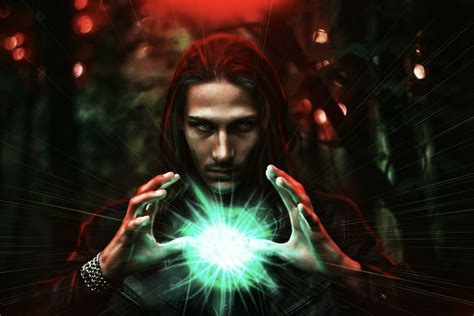
Barry Rountree provides invaluable information from a nineteenth century source, Notes and Queries:
‘F. C. Birkbeck Terry posted the following question in the September 12 1885 issue: Seventh Son Superstition – Belief in the power of a seventh son to heal diseases is no doubt of considerable antiquity, but I do not remember to have seen it referred to in our dramatic literature, though probably there are several references besides the one here quoted:
“Whether my cure be perfect yet or no, It lies not in my doctor-ship to know. Your approbation may more raise the man, Then all the Colledge of physitians can; And more health from your faire hands may be wonne, Then by the stroekings of the seaventh sonne.” B. Brome, The Antipodes, the Epilogue, 1640.
‘This passage evidently has reference to the cure of the king’s evil. This belief seems still to prevail in Stornoway [Isle of Lewis, Scotland]… Folk-lore Journal, volume i. pages 59, 60… 397. At page 31 of volume ii is the following passage: “The power of the seventh son of a seventh son is very interesting to us, as being quoted by Cornelius a Lapide as existing in Flanders in his day, some two hundred years ago.” … Folk-Medicine, by Mr. W. G. Black (Folk-lore Society).
The several replies to this query were published in the December 19 1885 issue. One of the more fascinating responses quotes a text from 1660 as follows:
“It is manifest, by experience, that the seventh male child, by just order (never a girle or wench being born between) doth heal only with touching (through a natural gift) the king’s evil.”
‘The King’s evil is… Tuberculous cervical lymphadenitis, otherwise known as scrofula.’
Scrofula ‘refers to a lymphadenitis of the cervical lymph nodes associated with tuberculosis as well as nontuberculous mycobacteria. The second part of the quote above, ends as “… which is a special gift of God, given to kings and queens, as daily experience doth witnesse.” It was written by Thomas Lupton, in the second edition of his book, A Thousand Notable Things in 1660.
John Huculiak adds: ‘The Seventh child of the Seventh child are called a “Luck Child”. They are an auspicious sign for the frontier family, and the lore stems from the sixteenth century, where there were written records of curing the “King’s Evil”. If you simply look at it from a practical standpoint, this feat shows abundance, “healthy” stock, and many hands for working, thus bringing in [and] turning out more. When so many children could survive and thrive in one family; other families believed that it was supernaturally-influenced, and maybe it was…
The seventh daughter to the seventh daughter is gifted with “second sight” as known as the gift of prophesy. A seventh son is gifted with healing ability and/or a green thumb for Life. Now, not every culture saw the seventh child of the seventh child as a blessed; some attributed that they would suck the Life from the mother, even turn into a vampire (Romanian lore). There really is not much else recorded about the Seventh child of the Seventh child until the 1960’s where the New Age took the idea and ran amok with the concept.’
According to Huculiak, a seventh child of a seventh child is a lucky child. Though it is not clear whether for good or bad luck. Also, he makes an important distinction between a male having the gift of healing; whereas a female possessing the prophetic gift of second sight. This belief in a daughter’s gift of prophetic vision is held in Scotland.
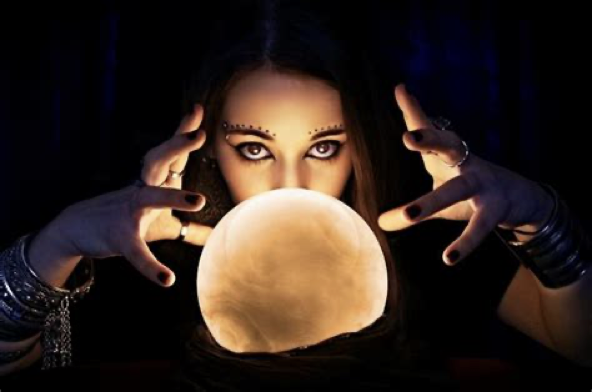
It is worth noting that ‘in many cases seventh sons (who are not born to a seventh son) are also said to have supernatural or healing abilities.’ Online Encyclopaedia: ‘To qualify as “the seventh son of a seventh son” one must be the seventh male child born in an unbroken line with no female siblings born between, and to a father who himself is the seventh male child born in an unbroken line with no female siblings born between. The number seven has a long history of mystical and biblical significance…’ of which we will investigate.
Regional variations of the folklore surrounding special powers of a seventh son include the following.
Encyclopaedia: ‘In Italian legend, “Ciarallo” was a seventh son of a seventh son who had the power to enchant and recall snakes, and who was immune to snake venom. Ciarallo was not only a seventh son, but underwent a special initiation rite called “inciaramazione”. Customarily, one would ask Ciarallo’s intercession when a snake was discovered in the house. Ciarallo would answer these requests by attracting the snake with a whistle. He would also perform the inciaramazione rite on other people to ensure protection from snakes by spreading a special oil on their arm. Children were led to Ciarallo by their mothers to get protection.
In some Latin American countries [specifically Argentina, Uruguay, Paraguay and Brazil], the seventh son of a seventh son is believed to be cursed to be a werewolf, lobizón, Luison (in Paraguay) or lobisomem (the Portuguese word for “werewolf”). To prevent this, the newborn should be baptized in seven different churches. Alternately, he may be baptized under the name Benito, with his eldest brother (the eldest son of their father) as his godfather. The local myth of the lobizón is not connected to the custom*… by which every seventh son (or seventh daughter) born in Argentina to “legitimately married parents of good conduct and moral character” is eligible to become godchild to the president.’
The Legendary Powers of a Seventh Son of a Seventh Son, Wu Mingren, 2019:
‘In 1907, [a]… custom* about the seventh son was created. According to this custom, which originated in Germany, the reigning prince would be the sponsor to a seventh son of any of his subjects. When Enrique Brost and Apolonia Holmann, who were Volga Germans from south eastern Russia, immigrated to Argentina in the early 1900s, they brought the custom along. They requested the then Argentinian president, Jose Figueroa Alcorta, be their seventh son’s godfather. The president agreed to their request and this tradition has been kept till today. In 2014, Yair Tawil, a seventh son, became the godson of Argentina’s president, Cristina Fernandez de Kirchner.’
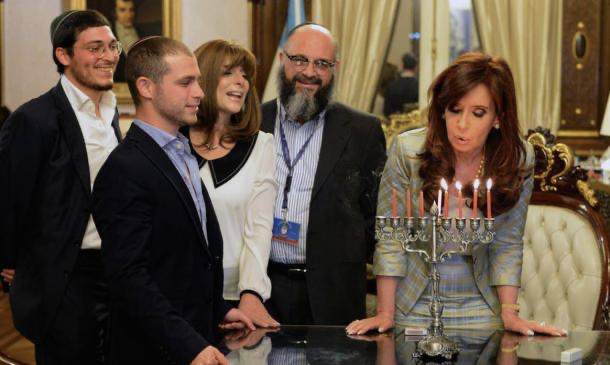
Yair Tawil, the seventh son, front left, becomes the godson of Argentinian president Christina Fernandez de Kirchner, front right.
In a similar vein to the Argentinian custom, albeit a rather complicated political issue, is the 2010 article in The German Way & More, which refers to an article entitled, Unlucky number seven causes headache for German President, where it states: ‘Thanks to a law made in 1949, German families may request that the German President act as godfather to their seventh child, in the event that one is born. President Christian Wulff was called upon to fulfill this role to a family in the northeastern federal state of… Mecklenburg-Western Pomerania. What may seem at first glance as a run of the mill duty of a figure head became a loaded decision. Apparently, the family in question has close links to Germany’s far-right National Democratic Party… [with] neo-Nazi leanings… as German President, it is more of an honorary vs. hands-on role to be godfather… Wulff’s decision has been highly criticized by local politicians… They voiced that he ought to have condemned the family’s political standpoint and activities and instead have given them a leg up in their political aspirations by association… Wulff… states that this decision is about the child and not about its parents. In fact, to deny the child’s legal right to have the German President as his godfather… would in fact be taking a fascist stance.’
Wu Mingren: ‘The myth of the luison originates with the Guarani, an indigenous group of people from Paraguay. In Guarani mythology, the luison was the seventh and youngest offspring of Tau, an evil spirit, and Kerana, a mortal woman. In the original story, the luison is said to be the God of Death and had a horrendous figure. His face was long and pale, and much of his body was covered with long dirty hair. He also had frightening eyes and the stench of death and decay around him. It was perhaps interaction with European colonists that transformed this myth overtime, as the luizon changed from a God of Death into a werewolf.’
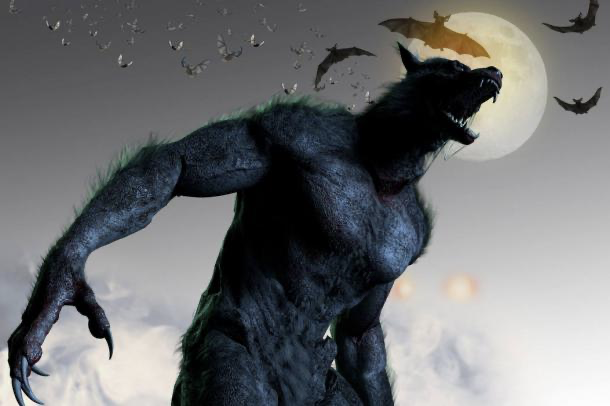
‘It is believed that on the night of a full moon, especially if it fell on a Friday, the seventh son in a family of all boys, after he reached the age of 13, would transform into the luison. Like the European werewolf, the luison would terrorize the night by hunting and killing, and spread its curse through its bite.’
Encyclopaedia: ‘Raymond T. McNally and Radu Florescu describe the Transylvanian folk belief that “the seventh son of a seventh son is doomed to become a vampire.”
According to Edward Augustus Kendall in Travels through the Northern Parts of the United States, in the year 1807-1808, while he visited the Newgate copper mine and prison, he met an innkeeper who told him that “there was to be found in the surrounding hills, a black stone, of a certain species, through which a seventh son of a seventh son, born in the month of February, with a caul on his head, can discern everything that lies in the depths and interior of the globe.” The author speculated that the importance of mining to the community gave rise to the localized belief.’
The tradition that a seventh son had the power to cure the king’s evil was also believed in France. ‘He was called a “Marcou” and branded with a fleur-de-lis. The Marcou breathed on the part affected, or else the patient touched the Marcou’s fleur-de-lis.’
Encyclopaedia: ‘In Lancashire and particularly in Blackburn there was, in the eighteenth and nineteenth centuries, a tradition of calling seventh sons of seventh sons (and seventh sons) ‘Doctor’ (forename) because of their supposed abilities as healers.’
The Diary of Walter Yonge 1604-1628, published by the Camden Society in 1847 and edited by G Roberts, says regarding a false claim: “In January, 1606-7, it is reported from London by credible letters, that a child being the seventh son of his mother, and no woman child born between, healeth deaf, blind, and lame; but the parents of the child are popish, as so many say as are healed by it. The Bishop of London, Doctor Vaughan, caused divers [people] to be brought to the child as aforesaid, who said a short prayer as [he] imposed his hands upon, as ’tis said he did unto others; but no miracle followeth any, so that it appeareth to be a plain lie invented to win grace to the popish faction.”
Another contributor to Notes & Queries in the June 12, 1852 issue observed: “In Saltash Street, Plymouth [England], my friend copied, on the 10th December, 1851, the following inscription on a board, indicating the profession and claims of the inhabitant: ‘A. Shepherd, the third seventh daughter, Doctress.’”
This is an amazing advertisement of a woman born as a seventh daughter of not just the second but the third generation. Here we have an example of a female who had healing powers and not just an exclusivity of a male. This isn’t a surprise as ‘there was a general belief in Britain that the seventh son of a seventh son was destined to be a physician and would have an intuitive knowledge of the art of healing, often curing a patient simply by touching an afflicted part. This belief also extended to the seventh daughter of a seventh daughter’ according to one source.
Domestic Annals of Scotland from the Reformation to the Revolution, Robert Chambers, 1858, states that in February 1682, Hugh McGie “… gave in a bill to the Privy Council, representing that, by the practice of other nations, any tradesman having seven sons together, without the intervention of a daughter, is declared free of all public burdens and taxes, and has other encouragements bestowed on him, to enable him to bring up the said children for the use and benefit of the commonwealth; and claiming a similar privilege on the strength of his having that qualification. The Council recommended the magistrates [of Edinburgh] to take Hugh’s seven sons into consideration when they laid their ‘stents’ (trade taxes) upon him.”
It is in Ireland, where the seventh son of a seventh son was believed to be gifted as a healer and was attached to a general phenomenon known as ‘the “cure” (sometimes also called the “charm”). Belief in the efficacy of seventh son healers and other folklore related to healing persisted to the 20th century in parts of Ireland.’ Even the saliva of a seventh son was said to have healing properties.
A tradition in Donegal, Ireland claims that the healing powers of a seventh son ‘required a special ceremony at the moment of the infant’s birth. The woman who received the child in her arms [would] place in its hand whatever substance she decided that he should use to heal in later life. This substance could be metal (e.g., a silver coin) or a common substance like salt, or even hair’ so that ‘when the child was old enough, it would rub the substance and the patient would apply it to an afflicted part for healing purposes. There was also an Irish tradition similar to the Scottish belief that a seventh son of a seventh son possessed prophetic as well as healing powers.’
Astonishingly, the belief in these abilities is acknowledged in recent times. Two examples of healing of this kind, include Irishmen Danny Gallagher and Finbarr Nolan. They are called touch healers. Both men ‘recommend a sequence of two or three visits for maximum healing’ and are ‘credited with remarkable cures.’ Gallagher also “blesses” soil that is then mixed with water, before being applied to the afflicted area of a patient. Meanwhile Gallagher is ‘reported to have restored the sight of a woman blind for twenty-two years, and Nolan [claimed] to have successfully healed injured race horses as well as human beings.’ We shall return to these two men and investigate their gifts more fully.
Occult World, based on The Encyclopedia of Witches, Witchcraft and Wicca by Rosemary Ellen Guiley, 1989, 1999, 2008:
‘Seven is the most mystical and magical of numbers. Since the middle Ages, the seventh son of a seventh son is supposed to have formidable magical and healing powers: He is clairvoyant and can see Demons and witches that no one else can see. He is capable of casting powerful spells, and he possesses the ability to heal by a laying on of hands. The Pennsylvania Dutch hold in high regard the seventh son of a seventh son who is born into a family of witches, for his spells are considered more powerful than those of other witches and more difficult to break. The seventh daughter of a seventh daughter or a seventh son is supposed to be born with the powers of a witch, but with no connection to the devil. She can foretell the future and can heal the sick.’
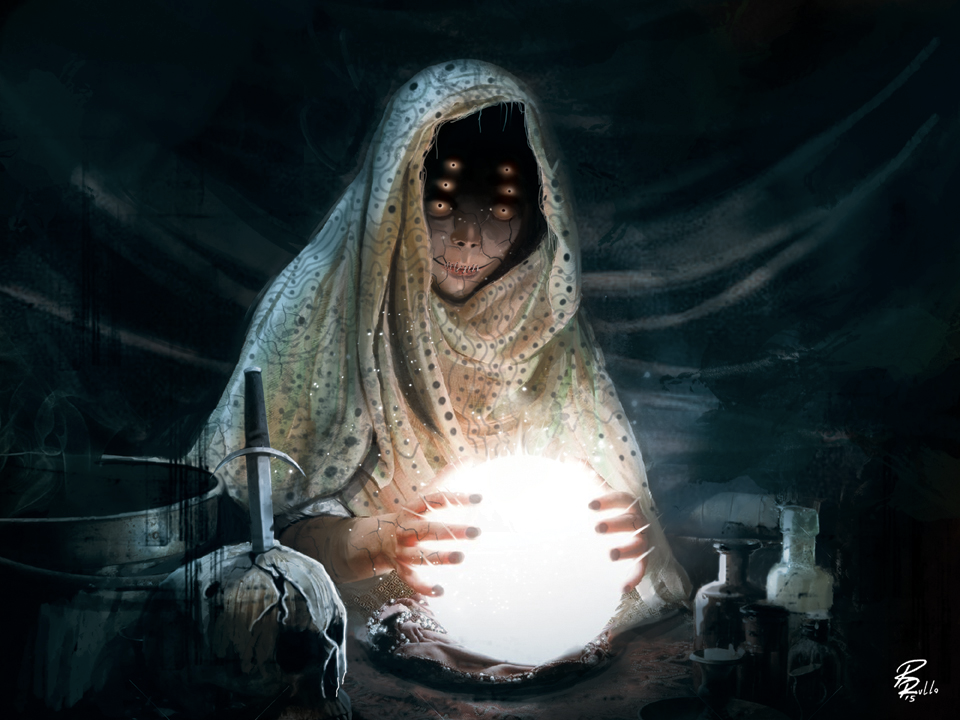
This raises a a number of salient points. We will study the number seven shortly. Magical powers are a step up from clairvoyance and healing capabilities. Perceiving demons and casting spells embrace the domain of evil and are not sourced from a Divine inspiration.
While laying of hands on the sick and anointing with oil is a ritual of a true believer, it can also be mimicked by a wicked spirit acting through a human instrument – Acts 28:8, James 5:14, Acts 8:9-11, 18-23. One could readily accept a seventh child of a seventh child born into a family with a legacy of witchcraft, would have special magical powers beyond an ordinary witch. Just as the Paraguayan luison was the seventh and youngest offspring born of an evil spirit and a human woman and formerly described as a God of Death, yet latterly as a werewolf.
A concerning anonymous online comment regarding the dark side of being simply a seventh child, written January 6, 2017:
“I am the seventh son of my [ten] siblings. When I was born, just months later my mother got pregnant right then but the child died after [he was six] months old. According to the doctor, the child who was the 8th of my siblings was actually my twin but… destiny put a space for me to [be] born uncontested as the 7th son. I am… kind of different… it seems like I am not really human… when someone [hurts] me… nature will revenge and hurt [them] back… I have a rare vision, my dreams often tell me what [will] happen tomorrow… When I… pray to God and talk to them I [can] feel I am so [close] to him. I could ask [for any] material thing and he [would] grant everything…
I am still [continuously] discovering myself because it seems like I am owned by someone. If I fall in love [with] anyone, they would be driven away from me. I am good looking, and charming but it seems like I am not lovable… very few [become] my girlfriend… seems like… destiny does not want me to be owned by anyone because I am… already owned by [the] unknown. I feel like a super cudgel or a stick of an immortal… being used… owned by a supernatural nature. Anyone who loved me would be blessed and anyone who hurt me would [suffer]… seems I could not see the answer of the questions [of] who really I am… not in the library and not in Scientific theories… now… what I know I am the seventh son.”
Alison Laurie: ‘… 7 years old [is] regarded as [the] age of reason, when an infant [becomes] a child, and [can] work, or later, the school age (still is in Scandinavia). Fourteen was the church confirmation age, and still is, it was also the school leaving age in some places. And 21 was/is the coming of age, with parties and celebrations, it was the age you could vote (now lowered to 18), and drink alcohol (also now lowered). But interesting – 7, 14, 21. All significant. And lifespan, in the bible, is 3 score and 10 = 70.’
Mingren: ‘Seven seems to be a magical number in many cultures, and is often imbued with mystical and religious attributes. In the Abrahamic faiths, for instance, it is believed that God created the world in seven days [rather, epochs], while in Greek mythology, the Pleiades were seven sisters who were the companions of the goddess Artemis’ – Chapter XXII Alpha & Omega; Chapter XV The Philistines: Latino-Hispano America; and article: Lilith.
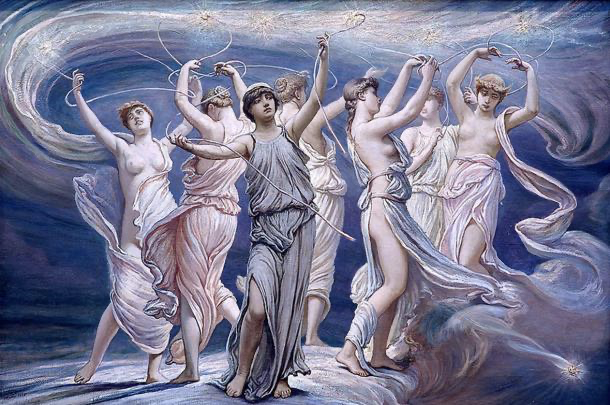
In the Greek myth of the Pleiades, a group of seven sisters were transformed into a cluster of stars – Article: The Pyramid Perplexity.
‘Other groups of seven include the Seven Wonders of the World, the Seven Sages of Greece, and the Shichi Fukujin (Seven Gods of Fortune) of Japanese mythology. In folklore, seven also has a special role in the order of birth.’
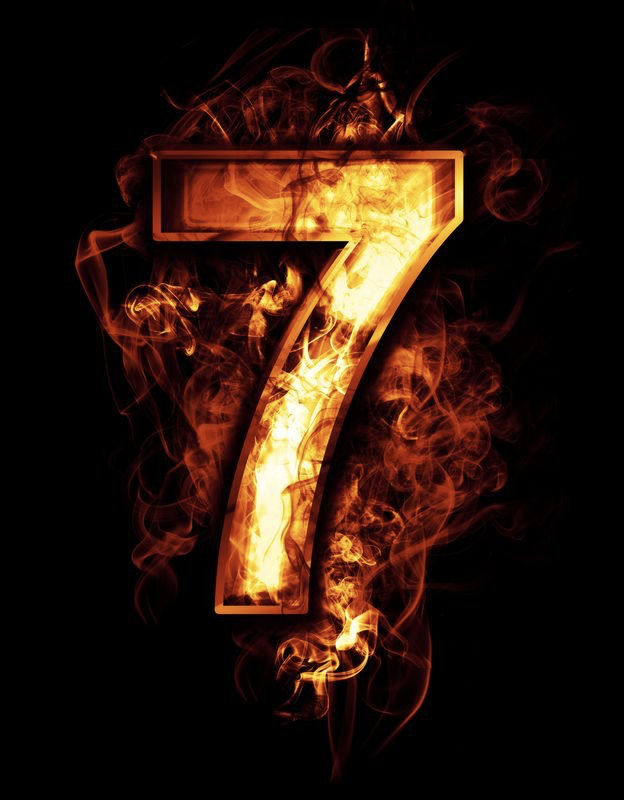
The number seven in numerology is equated with the intellect; inner wisdom; the metaphysical and occult mysteries; and a person led by this number is often a loner, eccentric, intuitive, private, skeptical and reserved.
The Tarot card equivalent is interestingly, The Hermit – refer article: Thoth. Sarah Regan: ‘While the archetype of the hermit can symbolize many things, spiritually it… [is] someone who withdraws a bit from society or cloisters themselves in order to study the spiritual mysteries.’
The Complete Idiot’s Guide to Numerology, Kay Lagerquist & Lisa Lenard, 2004:
‘The energy of the number 7 is… focussing inward… leaving the material world to turn to the world of spiritual understanding. The 7’s energy is spent on inner seeing… The 7 operates on a different wavelength than others… The 7 is often associated with magical powers… The number 7 is indivisible, and it represents the perfection of the God energy.
… the Mayans believed in a seven layered sky and that the number 7 was the number for orientation in space. In early Egypt it was believed that there were seven paths to heaven… seven heavenly cows, and Osiris, Egyptian god and judge of the dead, [led] his father through the seven halls of the netherworld [that is, hell].’
Jaliessa Sipress: ‘In numerology, the number 7 is a wild card, associated with unpredictable spiritual energy. Connected with the angelic realm and divine intervention, number 7 encourages you to try your luck and let the chips fall where they may.’
Kay Lagerquist: ‘Master Numbers indicate spiritual gifts that make them highly sensitive to intuition, extrasensory perception, and the world of higher guidance, including celestial beings, other life realities, and universal spiritual law.’ Number 77 is the master of spiritual energies.

Tanya C Richardson: “Angel numbers are a synchronicity, or a meaningful coincidence – divine guidance from angels and the universe.” Vanessa Hall: ‘The angel number 777 represents… spiritual awakening, divine intervention and in some cases, luck!’ Brett Larkin: ‘The number 7 is a highly mystic and spiritual number, so having it tripled makes 777 very powerful indeed… this number is… also connected to the magic of manifestation.’

In the Bible, the number seven signifies something finished, completed and perfected. Particularly in association with the Divine. The number seven in its singular form is mentioned 463 times in the King James Version of the Bible, with fascinatingly the most occurrences recorded 54 times each both in scripture’s first book Genesis and its last book, Revelation. If other variations of the word for seven, such as sevens, seventh and sevenfold are included, it brings the total to 591 times.
The number seven is heavily rooted in the creation, where it is used seven times in describing the Eternal’s creative work; with seven days in each Moon cycle; a seven day weekly cycle; and the Sabbath on the Seventh day – Articles: The Calendar Conspiracy; and The Sabbath Secrecy. There are seven colours in the spectrum; seven notes on the musical scale; and seven energy centres or chakras in the body.
There are numerous groups of sevens in the Bible. A few pertinent or interesting examples include the following according to Bible Study:
- The Bible, when it was originally canonized, was divided into seven major divisions. The total number of originally inspired books was forty-nine, or 7 x 7, demonstrating the absolute perfection of the Word of God.
- There are at least seven men in the Old Testament who are labeled “a man of God.” They are Moses (Joshua 14:6), David (2 Chronicles 8:14), Samuel (1 Samuel 9:6, 14), Shemaiah (1 Kings 12:22), Elijah (1 Kings 17:18), Elisha (2 Kings 5:8) and Igdaliah (Jeremiah 35:4).
- In the book of Revelation there are 7 churches as well as the same number of angels overseeing them. The book also contains seven seals, [seven] trumpet plagues, [and seven] thunders.
- Jesus performed 7 miracles on God’s holy Sabbath Day… 1) Jesus healed the withered hand of a man attending synagogue services (Matthew 12:9). 2) At a Capernaum synagogue [Jesus cast] out an unclean spirit that possessed a man (Mark 1:21). 3) Right after the above miracle Jesus heals Peter’s wife’s mother of a fever (Mark 1:29). 4) A woman attending synagogue, who was made sick by a demon for eighteen years, is released from her bondage (Luke 13:11). 5) At a Pharisee’s house eating a meal with the host and several lawyers, Jesus heals a man with dropsy (Luke 14:2). 6) A man who is disabled and unable to walk is healed at the pool of Bethesda (John 5:8 – 9). 7) Jesus heals a man born blind at the pool of Siloam (John 9:14).
- There are seven annual Holy Days (holy periods) in the Bible… They are Passover, the Days of Unleavened Bread (7 days), Pentecost, the Feast of [Trumpets], the Day of Atonement, the Feast of Tabernacles (7 days) and the Last Great Day. This cycle begins in the first month of the Hebrew calendar’s sacred year and completes in its seventh month.
- Jerusalem, historically, was a city believed to be built on 7 hills. These hills are Mount Scopus, Olivet, Corruption, Ophel, the original Mount Zion, the new Mount Zion, and the hill on which the Antonia Fortress was built.
In the Book of Genesis we read about the family of Cain. After Cain had murdered his brother Abel and the Eternal banished him, Cain was ironically and cowardly concerned for his own life. The Eternal replies in Genesis 4:15, ESV: ‘… “Not so! If anyone kills Cain, vengeance shall be taken on him sevenfold.” The Hebrew word for sevenfold is H7659, shib’athayim and means: ‘seven times.’ It derives from H7651, sheba, which is the Hebrew word for the number seven. It is not given why God chose this number over other spiritually perfect numbers in the Bible, such as three times or ten times for instance. The number three signifying a decision or finality and the number ten, judgement.
In the same chapter an important descendant of Cain, the evil Lamech is discussed – refer article: Na’amah. Interestingly, Lamech was the seventh generation after Adam, just as righteous Enoch was, who descended from Seth. Genesis 4:23-24, ESV: ‘Lamech said to his wives: “Adah and Zillah, hear my voice; you wives of Lamech, listen to what I say: I have killed a man for wounding me, a young man for striking me. If Cain’s revenge is sevenfold, then Lamech’s is seventy-sevenfold.”
Lamech met with the most unfortunate occurrence imaginable, in that it was he who inadvertently murdered Cain while out hunting. This happened in part because Lamech had poor eyesight and his son had mistook Cain for an animal. In the aftermath and the ensuing melee, Lamech accidentally killed his own son, Tubal-Cain. The similarity of his name with Cain, an interesting coincidence.
The Hebrew word for seventy is H7657, shib’iym, meaning: seventy. It derives from the word for seven, sheba. What is of note here, is that the Hebrew word used for sevenfold is not H7659, shib’athayim, but rather, H7651, sheba, which means seven. Yet this word can also mean: ‘sevens, seventh, seventeen, seventeenth’ and ‘seven times’ or ‘sevenfold.’
Why Lamech refers to seventy-seven times for his avenged life is not clear. The same way we do not know why the Eternal chose seven. That is, until we consider the root word for sheba, which is H7650, shaba. This word is key, for it means: ‘to swear, adjure, take an oath, to curse.’ It can also refer to the Eternal swearing by Himself. Thus in the context of Cain, the curse – not put upon Cain, but – on anyone who killed him, was to be sevenfold in severity. One could say Lamech paid an immediate price, in losing his third and perhaps youngest son and then later when his life was undeniably cut short in the global flood cataclysm.
The curiosity surrounding the number seven doesn’t stop in chapter four and continues in the following chapter. In chapter five of the Book of Genesis, the descendants of Seth are listed. Here there is another Lamech, who happens to be the father of Noah. This Lamech was the ninth generation after Adam and his life too, was cut short by the flood.
Genesis 5:30-31, ESV: ‘Lamech… after he fathered Noah… had other sons and daughters. Thus all the days of Lamech were 777 years, and he died.’
An angel number such as 777 is extremely rare in the scriptures. The only other one which this writer is immediately aware, is 666 – Revelation 13:18. Refer: Chapter XXI The Incredible Identity, Origin & Destiny of Nimrod; Chapter XXII Alpha & Omega; and article: Monoliths of the Nephilim.
A selection of people either claiming to be seventh sons of seventh sons or regarded as such, include the following individuals:
Glen Travis Campbell:
An American Country and Western singer, he was ‘born on April 22, 1936, in Billstown, a tiny community near Delight in Pike County, Arkansas, to John Wesley Campbell (a sharecropper) and Carrie Dell (née Stone) Campbell. Campbell was of Scottish descent and was the seventh son of 12 children. As a child he almost died from drowning. His family went to the Church of Christ, and Campbell’s brother Lindell became a Church of Christ minister. In 2011, Campbell said his mother was Irish; although his mother was born in the United States, her family had emigrated from County Tipperary’ in the Republic of Ireland. Campbell died August 8, 2017.
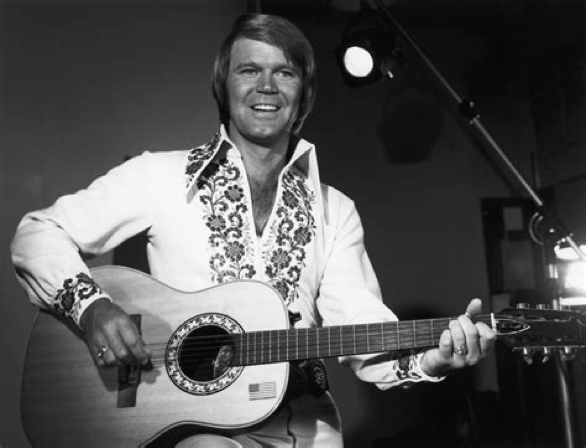
Perry Como (1912-2001):
Cheryl E Preston: ‘Singer Como [who was the seventh child of thirteen] discussed being a seventh son of a seventh son in interviews. He had two older sisters and only one older brother to survive until they were adults. He had three siblings who died in infancy and I assume they were boys. If the girls in Como’s family were the oldest and Perry the youngest, this would indeed qualify him for the honor with six brothers who preceded him. Some say his birth order is why he was so successful as an entertainer.’
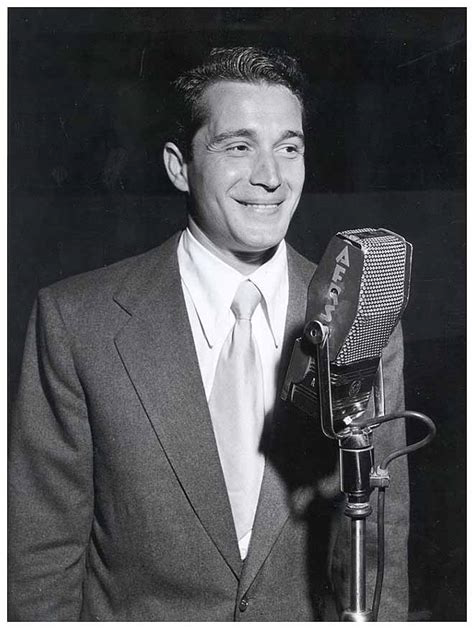
Without further information, there is some doubt regarding Perry Como’s credentials and more so with Glen Campbell’s. They share a similar gift and career in the music industry. Como was of Italian descent, while Campbell had both Scottish and Irish ancestry. Campbell’s heritage is of particular interest and this aspect will be studied in more detail.
Leonard Ray Dawson (June 20, 1935 – August 24, 2022):
American football quarterback who played in the NFL and the AFL for 19 seasons – primarily with the Kansas City Chiefs. Dawson quarterbacked the Kansa City Chiefs to a win in Super Bowl IV and is a member of the Pro Football Hall of Fame. Dawson was the seventh son of a seventh son and ninth of eleven children overall. As Dawson was the ninth child, it indicates there were two females born before him. If the two females were born first, and then seven sons, he would qualify as a seventh son; provided his father also qualified by the same rule. Dawson had two children of his own.
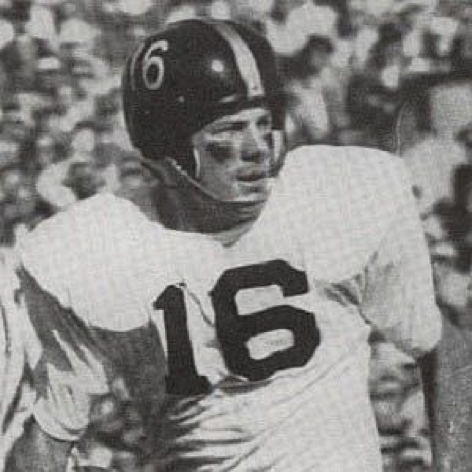
Ivor Verdun Powell MBE (July 5, 1916 – November 6, 2012):
Welsh football player and manager. He won eight caps for Wales. Powell was a seventh son of a seventh son, who said that “people used to keep pointing it out, but it didn’t mean a lot to me.”
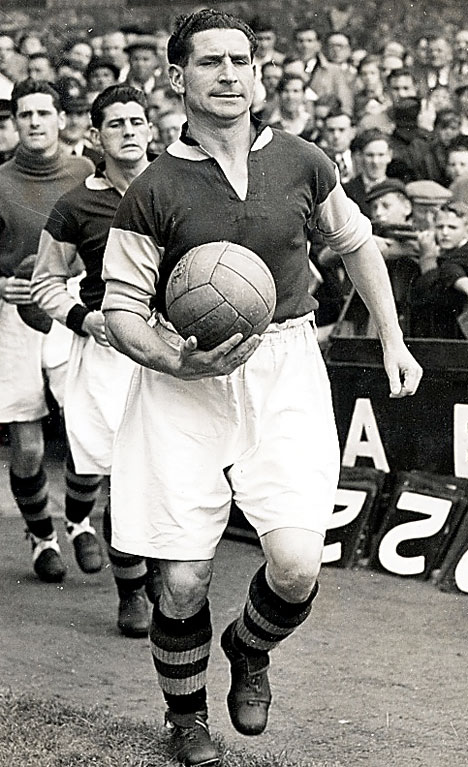
Both Powell and Dawson – like Como and Campbell – share similar careers. In this case, in the world of sport and related team sports at that. These four men are not on record in exhibiting or speaking about any gifts of healing or clairvoyant abilities.
Archille Noé Baillargeon (February 13, 1889 – January 29, 1940):
From Tecumseh, Ontario, Canada was the seventh son of a seventh son, being the eighth child of fourteen siblings – with a sister and six brothers preceding him – and credited with possessing extraordinary healing powers. Baillargeon had two children of his own.
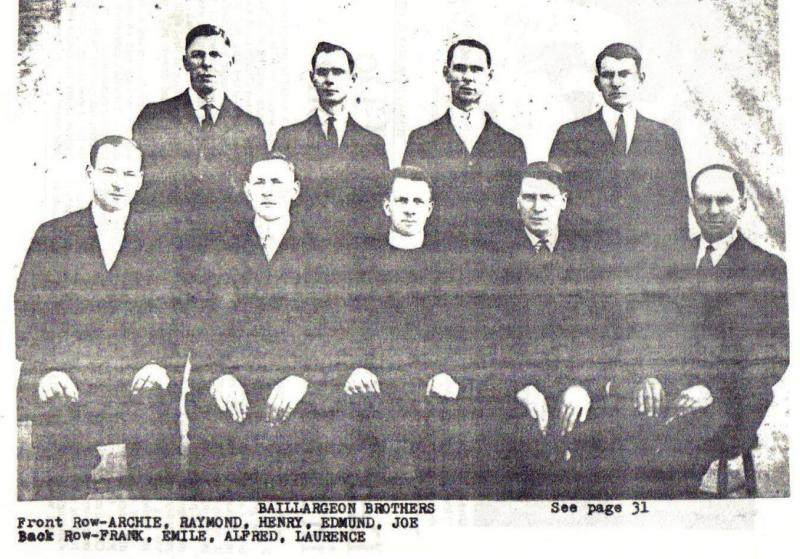
Baillargeon is described as having a gift of healing, yet there is scant information about him, or regarding any additional abilities. It is the next two deceased men, in which we have considerably more information documenting preternatural behaviour. Both make fascinating reading and without a doubt, bear the expected hallmarks typified by a seventh son of a seventh son.
Abram George (1914/16 – ?):
Mohawk faith healer from Akwesasne, New York. Darren Bonaparte – capitals his:
‘This young fellow garnered a lot of press in the late 1920’s and early 1930’s because of his abilities as a healer. The Massena Observer ran an article on February 17, 1927 under the headline INDIAN BOY IS CAUSE OF WORRY. The story dealt with the question of whether or not Indians lose their rights when buying a home off the reservation. The house in question was purchased for Abram George by his father, Mitchell.
“In Batavia, there lives an 11-year-old St. Regis Indian boy named Abram George. The boy has built up a reputation as a healer and, incidentally, a small fortune. His father, Mitchell George, has purchased expensive automobiles for the lad and puts him up at the best hotels when traveling. Now, he wants to buy a home for the boy and he doesn’t want it on an Indian reservation. Through an attorney, he asked the assemblyman to ascertain whether an Indian would lose his tribal rights, ceded to him by state and federal governments, if he bought a home outside the reservation…
Abram is credited not only with the ability to find bodies of drowned persons but with magical powers of healing and curing lameness. A St. Regis Indian, he formerly resided with his parents, nine brothers and two sisters between Hogansburg and St. Regis. He has been doing “private practice,” besides visiting the fairs in the fall.”
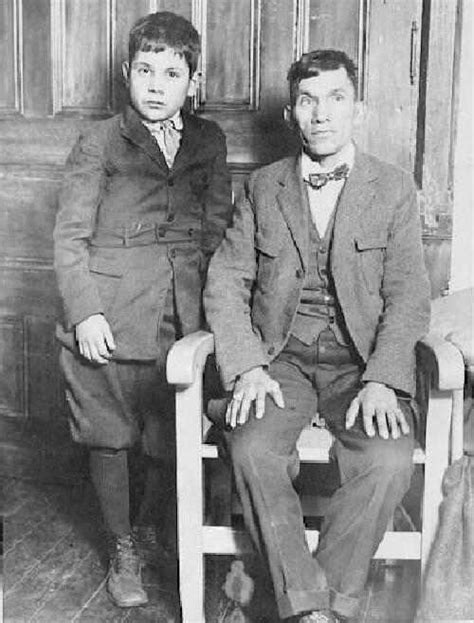
‘… March 10, 1927, the Massena Observer… “There is nothing boyish about the little red doctor… Years of traveling around the country and being held up as a supernatural being have given him a reticent manner and a countenance as solemn as that of Jiddu Krishnamurti, the much heralded ‘New Messiah,’ who recently came to this country from the Far East. He is a husky little chap of 12 years with the true bronze skin of his race and tousled shock of straight, black hair. He has unusually large jet black eyes that have a lustrous quality and intensity that command immediate attention” – Article: Are you an Old Soul… with a Young Heart. “He never questions his father’s orders and goes about his business with the matter of fact air of a practitioner…” The article goes on to suggest that his healing power stems more from the faith of those being healed than in the boy himself, who understands English but doesn’t speak it.’
“… While the powers claimed for the boy are explained by his father only in the statement that he is the seventh son of a seventh son, it is believed that this belief must be one of the Iroquois tribe or perhaps some clan of which the Georges are [members]. Seneca Indians on the Tonawanda reservation say they have never heard of such an Indian legend until the coming of the George family to Batavia. There is the belief that the seventh son of a seventh son is favored by luck, but as far as can be learned it is the first time that anyone has come forth with a statement that Indians thus endowed have a magic healing power…”
The article goes on to describe one Laverne Ellis, a Batavia boy who suffered from an attack of infantile paralysis that shrank his arms and legs and left him in a wheelchair. Abram George healed him of his afflictions, prompting his mother to declare the young healer “worth his weight in gold.”
“… [Abram] never speaks from the time he enters the home of a patient until he leaves – a nod or shake of his head or a smile being his only response to questions asked of him as he massages the atrophied limbs and twisted body parts of his patient.”
‘The Massena Observer ran another article about Abram George on March 20, 1930 under the headline, INDIAN HEALER RETURNS HOME… Like a medicine man, whose descendant he is said to be, the youth is revered… among the members of the St. Regis tribe for it was among them that the curative powers of the touch of his hands were first brought to light. Just at what time this seeming power was discovered is not known. In recent years he startled thousands with his apparent miracles.
Two years ago, when he was 14 years of age, accounts of a demonstration given by the boy at Rochester, swept through pages of newspapers and magazines. At that time, before a gathering of thousands of people, the boy is said to have given the healing touch to 75 people and was eagerly pressed for assistance by others who sought the touch of his hand. Again, while he was at Batavia near Tonawanda reservation, hundreds of letters came to him asking him to come to other cities and demonstrate his healing power, but it was decided that he must wait until he was 16 years of age before going out into the world on his curative missions…
Abram returns to Hogansburg after several weeks spent in Miami, Florida, where he mystified hundreds with demonstrations of his apparent power to heal by touch. At the Alcazar hotel in that city early in January of this year he gave a remarkable revelation of his miraculous healing before approximately 250 people. The crowd was amazed as afflicted persons announced that they had been helped by the touch of the boy’s hands… Some have attributed the boy’s miraculous powers to his descendancy. He is the seventh son of a seventh son and from this circumstance is believed to have been endowed with a sort of sixth sense. He is also a direct descendant of a great Indian healer and medicine man who lived in the days of the French and Indian wars when the powerful Iroquois tribes were supreme in the north…
Members of the St. Regis tribe and other followers of the youth, although unable to account for the work which he has done, stoutly declare that the healing touch of his hands has brought health to scores of afflicted. Abram George’s career as a healer eventually came to an end when he grew up, according to a member of the George family. He lived out the rest of his days in Akwesasne.’
Did Abram’s gift depart from him, or did he simply tire of the burden of his mission in helping and healing so many people. It is interesting that his gift was apparent from a very early age. We will find this is a common trait amongst seventh sons of seventh sons. It is worth noting his ancestry included a renowned healer and medicine man – ‘a person believed to have magical powers of healing; a shaman.’ Perhaps he too had been a seventh son. It is also notable that Abram’s father enjoyed and shared in the material trappings earned from his son’s healing powers.
James Murrell:
The seventh son of a seventh son, according to investigations by Arthur George Morrison – English writer and journalist. Online Encyclopaedia: Murrell ‘(c. 1785 – 16 December 1860)’ – baptised on October 9, 1785 – ‘also known as Cunning Murrell, was an English cunning man, or professional folk magician, who spent most of his life in the town of Hadleigh in the eastern English county of Essex. In this capacity, he reportedly employed magical means to aid in healing both humans and animals, exorcising malevolent spirits, countering witches, and restoring lost or stolen property to its owner… he was married in [August] 1812. He had seventeen children with his wife [though many did not survive infancy], and the family… [settled] in Hadleigh, where Murrell gained work as a shoemaker.’
Did Murrell also have a seventh son?
‘On a number of occasions his magical activities gained the attention of the local press. Although many residents valued his services and viewed him as a good and benevolent individual, his activities proved controversial and divisive. Many educated figures criticised what they saw as his role in encouraging superstition among the local population; his death certificate recorded his profession as that of a “quack doctor”… local folklore… surrounding him in the Hadleigh area, [included] the allegation that he had the ability to fly and to instantaneously transport himself vast distances.’ Remember this claimed feat of flying.
‘No images of Murrell survive. Accounts describe him as a short man who walked with his hands behind his back and hummed as he went. He was also noted for wearing a hard hat, bobbed tail coat, and iron goggles, while carrying a whalebone umbrella and a basket into which he placed the herbs that he collected. His appearance reportedly scared local children, of whom he was nevertheless fond. He cultivated an air of mystery about himself by keeping himself largely apart from wider community life, speaking seldom, and traveling largely at night.’
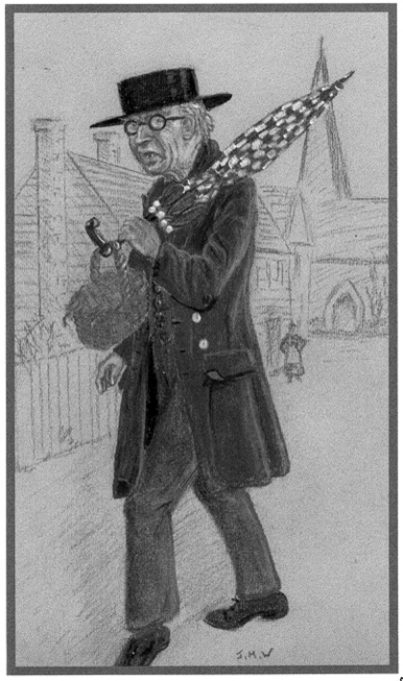
‘His house was locally known as a “place to avoid” and those visiting him reportedly often waited for some time outside, plucking up the courage to enter. Within the cottage, Murrell had drying herbs hanging from his ceiling, and his devices were reported to include a crystal, a mirror, and a bowl of water. Other items that Murrell used in his magical practices were a copper charm with which he would allegedly distinguish whether an individual was lying or not, and a “trick” telescope that supposedly enabled him “to see through brick walls”.
Murrell possessed a library of books, including works on astrology and astronomy, conjuration, and medical texts. He also wrote a number of personal notebooks containing information on such topics… He was reputed to cure sick animals by passing his hands over their affected area, muttering a prayer, and then hanging an amulet about their neck… the folklorist Eric Maple encountered claims that Murrell was able to summon anyone he wished using [witch bottles], including individuals who had gone overseas. Murrell experimented with the use of a witch bottle constructed out of iron; he had two such devices created by a local smith, Stephen Choppen, and had the plug at the mouth soldered up before the bottle was placed in a fire as part of an anti-bewitchment spell.’
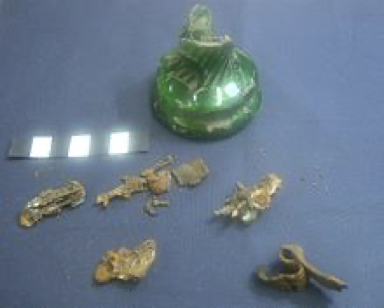
‘The idea behind this was that the bottle itself would not explode under the heat, and that thus it could be reused on other occasions. According to folklore collected by Maple, the smith’s attempts, which were initially unsuccessful, succeeded only after Murrell had recited a charm.
According to Maple’s research… [Murrell] was able to predict the death of a man to the “very day and hour” while another was that he also predicted the time of his own death to the very minute. It was claimed that on one occasion he was asked to provide the horoscope of a newborn child, but that he refused, stating that “Make the most of the child, you will not have it for long”, after which the child soon died, while when an old lady asked him to predict the future for her, he refused to do so for more than nine years ahead, with her dying in the eighth. Morrison found that the locals whom he spoke to – many of whom remembered Murrell from several decades before – found the cunning man to be “a white and lawful wizard [‘a man who has magical powers’], who warred against the powers of darkness with all his might”; they added that it was “no sin to employ the arts of a man like him.”
Maple found one woman, Mrs Petchey, who described him as “a smuggler and a bad man. He did things that wouldn’t be allowed today – them witchcrafts, I mean. Nowadays, people would say he’d sold his soul to the Devil, wouldn’t they? They’d put him away for his witchcrafts” – 2 Kings 21:6. ‘Conversely, Maple noted that Mrs Murrell, who was a descendant of James, described the cunning man as “a good man and a regular churchgoer”. According to the folklore obtained by Maple, Murrell would often have debates about Christian theology with a local parson, the Reverend Thomas Espin – who had been Professor of Pastoral Theology at Queens College, Birmingham – and that Espin expressed the view that Murrell “knows his Bible better than I do… He is either a very good man or a very bad one, and I can’t make up my mind which.”
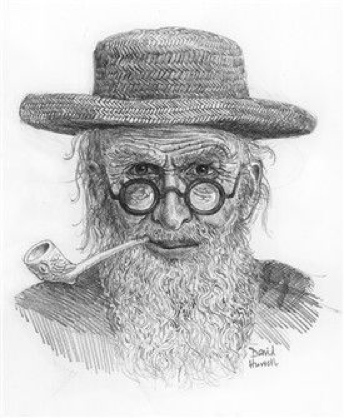
[A] story reports that Murrell took to his death bed aware of his oncoming demise, informing his daughter to turn away the curate “For I be the devil’s master as be well knowed. Clergymen den’t bother me in the oad time, they shan’t now.” Conversely, Maple recorded a story that in his final hours, Murrell was visited by the local curate; Murrell was frustrated by the latter’s attempts to administer religious consolation and eventually scared him off by shouting out “I am the Devil’s master”.
Murrell left no will. His son Edward later claimed that Murrell’s landlord soon buried a wooden chest with the old man’s papers in the garden of the cottage, deeming their associations with magic to be dangerous. Edward claimed that he subsequently dug the chest up again.’
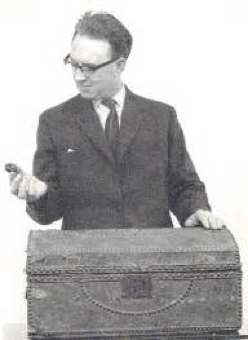
‘Murrell’s personal effects were treated as souvenirs, and several were treated as though they retained magical and supernatural associations for many years after his death. Murrell’s correspondences and papers – then contained in the wooden chest owned by his son – were examined by Morrison during the course of his research. Morrison discovered that Murrell was in possession of the manuscript [the] Key of Solomon grimoire* on which he based his magical practise.’
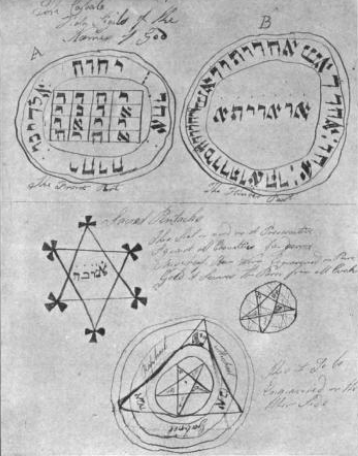
Reproductions of pages from Murrell’s books of magic; the page above depicts sigils and pentacles, the page below depicts a horoscope.
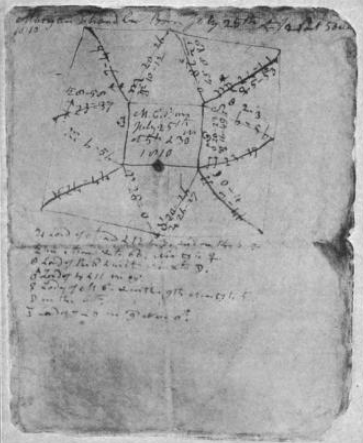
‘These texts survived until 1956, at which point they were burned by someone who did not believe them to be of any importance. Many of Murrell’s handwritten books were also lost, although his scrapbook of astrological data had survived until at least the late 1950s…’
The concluding paragraphs leave little doubt that Murrell was not a servant of the Eternal. Not because of his denunciation of the clergy, for this is rightly so, as they represent and teach a false christianity based on the theology of Paul – Articles: The Pauline Paradox; The Sabbath Secrecy; Arius, Alexander & Athanasius; and The Seven Churches – A Message for the Church of God in the Latter Days. Rather, the references to his being a wizard; possessing magical powers; practising black* magick; selling his soul to the devil; and claiming to be the devil’s master, in the vein of King Solomon – of whom we will have more to say later – Article: Na’amah.
As Reverend Espin was ‘double minded’ regarding Murrell’s character, he perhaps should have ‘rightly divided the word of truth’ to discern the answer – 2 Timothy 2:15, James 1:8. For it is no mean thing if someone is wily in debating the Bible – for even Satan can quote scripture – and presents themselves as wholly righteous when in reality they represent good and evil – Matthew 4:6, 2 Corinthians 11:14, Genesis 3:5.
Following, are examples from the hotbed capital of seventh sons of seventh sons: Ireland. The significance of which, will be investigated in-depth. The first two men are deceased, while the remaining four are presently alive.
Valentine Greatrakes (February 14, 1628 – November 28, 1682):
Known as Greatorex or The Stroker, was an Irish faith healer from County Waterford; who toured England in 1666, claiming to cure people by the laying on of hands. It is not clear if he was a ‘seventh son of a seventh son.’ He certainly exhibited the signs of one in the main, but with mixed results. Both his parents were English Protestant settlers. Encyclopaedia: ‘He seemed to have been very religious; his outlook was grave but simple. He said himself, that ever since that year 1662 he had felt a strange impulse or persuasion that he had the gift of curing the King’s evil… and this suggestion became so strong, that he stroked several persons, and cured them.
Three years after that, an epidemical fever was raging in the country, he was again persuaded that he could also cure that. He made the experiment, and he affirmed to his satisfaction that he cured all who came to him. At length, in April 1665, another kind of inspiration suggested to him, that he had the gift of healing wounds and ulcers; and experience, he also said, proved that he was not deceived. He even found that he cured convulsions, the dropsy, and many other distempers.’
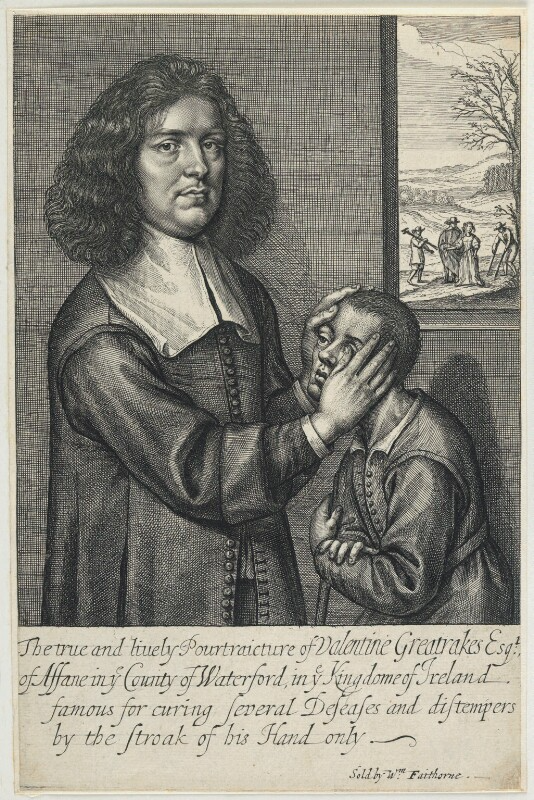
‘Robert Phayre… who had served in his regiment… [was] cured… in a few minutes of an acute ague’ in 1665. Greatrakes had served as a lieutenant in Lord Broghill’s regiment in the English Parliamentary army in Ireland in 1649, campaigning in Munster against the Irish Royalists. ‘John Flamsteed the famous Astronomer, (then aged 19) went over to Ireland… to be touched by Greatrakes for a natural weakness of constitution, but received no benefit.’
Even so, ‘crowds flocked to him from all parts, and he was reported to have performed such extraordinary cures, that he was summoned into the Bishop’s court at Lismore, and, not having a licence for practising, was forbidden to lay hands on anyone else in Ireland… Greatrakes was invited to England by his old commander, Lord Broghill… to cure Anne Viscountess Conway of an inveterate headache. He arrived in England in early 1666 but failed to cure the Viscountess. Undaunted, he travelled through the country, treating the sick.
King Charles II, being informed of it, summoned Greatrakes to Whitehall. While unpersuaded that Greatrakes had miraculous power, the king did not forbid him to continue his ministrations. Greatrakes went every day to a place in London where many sick persons, of all ranks in society, assembled. Pains, gout, rheumatism, convulsions and so forth were allegedly driven by his touch from one body part to another. Upon reaching the extremities, reportedly, all symptoms of these ailments ceased. As the treatment consisted entirely of stroking, Greatrakes was called The Stroker. Greatrakes ascribed certain disorders to the work of evil spirits. When persons possessed by such spirits saw Greatrakes or heard his voice, the afflicted fell to the ground or into violent agitation. He then proceeded to cure them by the same method of stroking.’
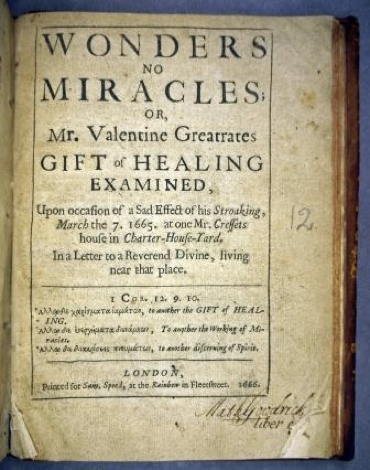
‘Greatrakes returned to Ireland in 1667, and resumed farming in 1668… Although he lived for many years, he no longer kept up the reputation of performing those strange cures which made him a name. However, his case is very singular, that on the strictest enquiry no sort of blemish was ever thrown upon his character, nor did any of those curious and learned persons, who espoused his cause, draw any imputation upon themselves.’
It would seem like Abram George, Greatrakes went into retirement. Was it to escape the responsibility his – sometimes happenstance – gift of healing weighed upon him? It is testament to Greatrakes that his character was described as blameless. We will confirm with subsequent healers that like Greatrakes, not all patients were healed. This is notable for a number of reasons, which we will discuss. Greatrakes, unlike George and Murrell, was a Christian and so ‘faith healer’ is an applicable term. Though not all healers are comfortable with the religious connotation and distance themselves from this label.
Finbarr Thomas Nolan (October 2, 1952 – June 20, 2020):
Encyclopedia: An ‘Irish healer who [was] the seventh son of a seventh son, and was thus, according to folk tradition, destined to begin healing by touch. He was born… at Loch Gowna, county Cavan, Republic of Ireland. His mother stated “I knew…God would give him the power to heal.” There were requests for healing when Nolan was only three months old, but his mother insisted that healing wait until the boy was at least two years old. At that time, a man brought his five-year-old child, who was suffering from ringworm. Nolan’s mother circled the spots with holy water, making the sign of the cross in the middle, then placed the two-year-old Nolan’s hand on each spot in turn, while she prayed for healing and asked her son to repeat the prayers after her. She claims that the ringworm was cured after two visits.’
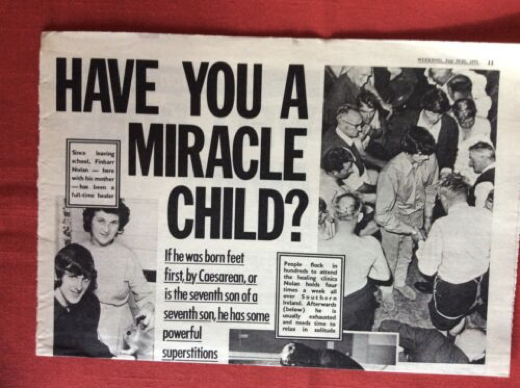
‘However, Nolan did not immediately undertake regular healing, although at the age of nine he touched the paralyzed hand of a local hotel proprietor and the hand became normal in three days’ time. The father of this man was confined to a wheelchair with severe arthritis, but the day after Nolan touched him he was able to use his hands, and a month later he had recovered sufficiently to resume his job as a butcher.
At the age of sixteen, while still attending school, Nolan was asked to go to Donegal to cure an aunt. She notified the local newspaper, with the result that the young Nolan arrived to find a crowd of three hundred people and a television film crew. For several weeks afterward, some five thousand people a day came to his home for healing, and he touched them in groups of 14 or 15 at a time in the kitchen of the house’ – Matthew 14:13-21. ‘After that Nolan decided to leave school and devote himself full time to healing.
His reputation as a healer spread rapidly, and visitors came from around the world for treatment. Since county Cavan is located near the border of Northern Ireland, the political unrest and disorders began to discourage visitors, so Nolan moved with his parents and brothers to a house in the suburbs of Dublin. Here the large number of visitors seeking healing soon made it difficult for the family to live a normal life in an average-sized house, so Nolan hired halls and hotel rooms for regular clinics.’
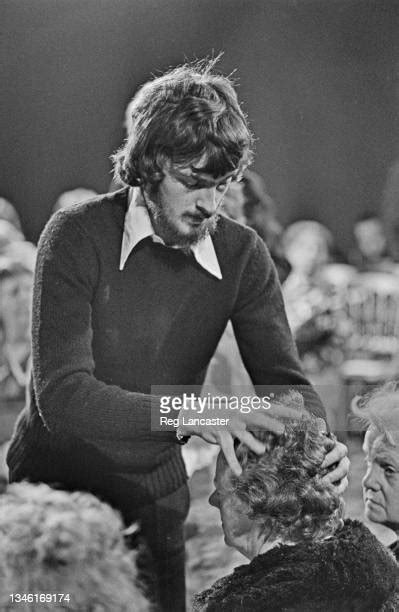
‘In the early period, Nolan had been influenced by his mother’s religious outlook and used holy water, making the sign of the cross when touching each patient, but eventually he discarded such specifically Catholic tradition. As he said: “It deterred a lot of Protestants and I have nearly as many Protestant patients at my clinic as I do Catholic.” Moreover he came to believe that his healing power had nothing to do with religion, and rejected the term “faith healer.”
He stated: “People should understand my healing has nothing to do with faith; I believe my power is a gift… I’ve proved that faith is not needed by curing animals and babies.” Indeed, he became well known for treating injured race horses, and one horse he treated won nine races afterward.
His healing power appears to be in his right hand, and he therefore places it on each part of a patient’s body that is afflicted. He lays his hand on the patient for several seconds and does not himself feel anything unusual happening, although patients often state that they feel a sensation of heat. His healing technique was monitored at a Belfast hospital, and it was found that during healing sessions there were changes in his respiration, pulse rate, and the electrical potential of his skin.’
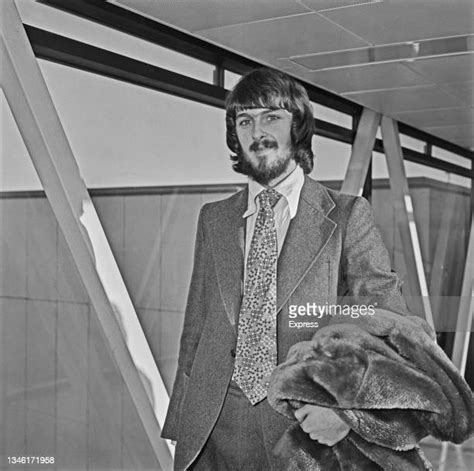
‘Like other seventh son healers, he has found that three visits are usually necessary. Patients sometimes feel worse after the first healing session, usually a sign that some changes have commenced. Healing is usually consolidated at the second and third visits. Most patients pay a small voluntary contribution for healing, but some wealthier individuals have been very generous. An elderly lady in New York suffering from rheumatoid arthritis paid for Nolan’s 6,000-mile journey and gave him an additional check for several thousand dollars. Nolan has also flown to Washington to treat a young Vietnamese war soldier. Nolan has held clinics in London as well as the United States and is credited with some remarkable cures.
Nolan is an amiable and, apart from his healing activity, eminently normal individual, with none of the mystique of many professionals in the paranormal. He does not think about anything in particular during the laying on of hands and exudes a friendly matter-of-fact atmosphere.’
Gail Walker, 2004: ‘In the 1970s he made a point of not charging a fee for his services but, understandably, grateful clientele were very generous [consultations later cost £25]. Finbarr… began living a life of considerable luxury. He had a beautiful detached home. He drove fast cars. But some thought it was all a bit incongruous, given the day job.’
Liam Collins: ‘With his playboy good looks, long hair and black beard, Finbarr Nolan brought show business glamour to the old-fashioned practice of faith healing, and for a time was as rich and famous as a show business celebrity. In his heyday, the softly spoken… ‘seventh son of a seventh son’ was said to be taking home “sacks of cash” for “laying” hands on the sick…’
Walker: ‘In any case, the taxman called and bankruptcy followed. Speaking at his home in Dublin, Finbarr, now 51, balding and a father-of-two [sons], is philosophical about his career – and, indeed, about life in general. He doesn’t so much blame speculation over his earnings for the wane in interest, as an older superstition being superceded by the sophistication of modern life. “More people are more educated now, and they look for a doctor with as many letters after his name as possible,” he says. “What I do, based on me being the seventh son of a seventh son, isn’t their thing at all. They’d never think that I can cure them.”
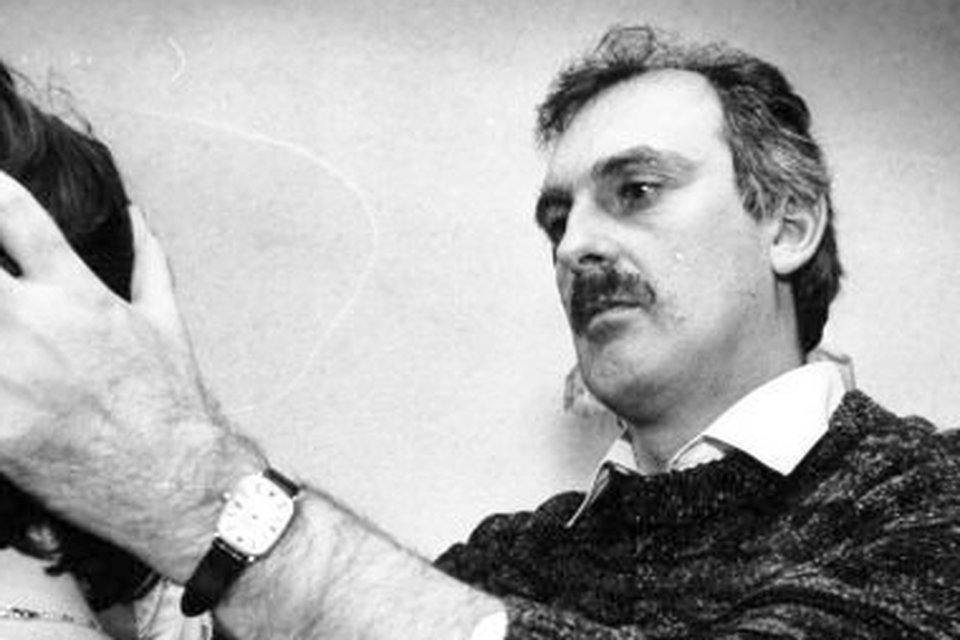
‘In fact, Finbarr doesn’t promise that he can cure anyone. Asked to rate his chances, he puts it as “at best, 50/50.” He says: “I’ve always been upfront about it. It might work, it might not. “But I’ll certainly have a go at anything. I have had some measure of success with every condition but also some measure of failure with every condition.”
Among his most publicised cases in Northern Ireland was that of Anthony Milligan, from Co Down. In 1978 he had cancer of the pancreas and doctors had given him just six weeks to live. But he’s still alive today. “Of course Anthony’s story is unbelievable,” says Finbarr. “If I hadn’t been there myself, I wouldn’t believe it. But it happened. “I was staying at a hotel in Northern Ireland and more or less as a favour to the owner I agreed to go out and see Anthony. He was too ill to come to me. “After I saw him I even remember saying to someone that I wouldn’t be back to see that man again because he was so ill. “But two years later I was taking a clinic in Lisburn and Anthony walked through the door. I couldn’t believe it. I thought he would have been dead and buried. He’s still knocking about today.”
Finbarr’s own health has been poor since he was was almost killed in an accident 10 years ago. He was hit by a lorry while out cycling on a bike his wife Caroline had bought for him to tackle his middle-age spread. He was left with chronic back pain – and, no, the healer cannot heal himself. Perhaps unsurprisingly, there were once plans to turn his life story into a Hollywood movie. But they collapsed at the last moment.’
It is of consequence that Nolan came to view his ability to heal as a gift and not one of faith, in contrast with his religious mother. The use of holy water and making the sign of the cross, while indicative of Catholicism are not traditions associated with the Bible, Christ, the apostles or the early church. The fact Nolan rates his success as 50% also underlines that his healing is certainly not based on his faith, though it does not necessarily negate faith exhibited on the part of the patients involved.
The question of faith is an important one, for when Christ returns, he asks whether he will even ‘find faith on the earth’ – Luke 18:8. Nolan realises his gift does not stem from faith, but rather his status as a ‘seventh son of a seventh son.’ Thus, the question arises: where did Nolan’s gift come from? For a gift of healing has a spiritual source. Matthew 10:1, ESV: ‘And he called to him his twelve disciples and gave them authority over unclean spirits, to cast them out, and to heal every disease and every affliction.’ Yet how can one know what type of spirit is involved? Whether the Holy Spirit, or an infernal one?
1 John 4:1-6
The Voice
‘… I warn you: do not trust every spirit. Instead, examine them carefully to determine if they come from God, because the corrupt world is filled with the voices of many false prophets. Here is how you know God’s Spirit: if a spirit affirms the truth that Jesus the Anointed, our Liberating King, has come in human flesh, then that spirit is from God. If a spirit does not affirm the true nature of Jesus the Anointed, then that spirit does not come from God and is, in fact, the spirit of the antiChrist. You have heard about its coming; in fact it is already active in the world… Whoever is not from God will not listen… This is the way we discern the difference between the spirit of truth and the spirit of deception.’
It is staggering beyond comprehension then, that nearly all of Christianity promulgates and believes a falsehood, perpetrated by the doctrine of the Trinity, which denies Christ was created by God and fully human while on the Earth and teaches he was ‘God in the flesh’ instead – the very spirit of the antichrist – refer article: Arius, Alexander & Athanasius.
How does one recognise a true believer? Isaiah 66:2, ESV: ‘… But this is the one to whom I will look: he who is humble and contrite in spirit and trembles at my word.’ A true servant of God and therefore a true healer, believes and lives by, the word of God – Matthew 4:4.
In what manner does a true healer perform a divine healing? James 5:14-16, NTFE: ‘Are any among you sick? They should call for the elders of the church, and they should pray over the sick person, anointing them with [olive] oil in the name of the Lord. Faithful prayer will rescue the sick person, and the Lord will raise them up. If they have committed any sin, it will be forgiven them. So confess your sins to one another, and pray for one another, that you may be healed. When a righteous person prays, that prayer carries great power.’
It is not this writer’s intention to denigrate Nolan’s real healings which were genuine wonderworking, but to call attention to his and other healers – no matter how well intentioned – who either heal without acknowledging Christ, or who are mislead by a deceiving spirit… and therefore not healing by the authority of Jesus Christ and the power of the Holy Spirit.
The electricity registered on Nolan’s skin when laying his hands, confirms that he was a vessel for a force greater than himself. It behooves all healers to question what exactly they are channeling and to what or to whom they are serving as a medium and acting as a conduit for energy transmission – Article: DEATH: A Dead End or a New Beginning? Thus, it is truly incredible that healers and particularly seventh sons of seventh sons, may devote their whole lives to a practice they are quite unable to explain. In essence having faith in its reality and in its results; yet without ever comprehending the source.
Finally, two vital points which distinguish true healings from, let’s say counterfeit ones, though this does not mean they are necessarily less genuine, just less miraculous. The first is the question of renumeration. Nolan originally accepted donations – some generous – and then later, began charging a ‘modest’ consultation fee of £25.
This would seem reasonable no doubt, as expenses requiring travel and hiring of halls or hotels require payment. But herein lays the issue, for healers discovering their gift then think they must use it indiscriminately, widely and often. Yet the New Testament example, is one of discrimination and is predicated on healing the few who either exhibit faith; who are deserving; or who by being healed, the example furthers the good news of the gospel message – giving glory to God and Christ.
Nolan endeavouring to heal 5,000 people a day, is in no way supported by the scriptures, no matter how well intentioned he was. By performing healing in this manner, it focuses attention on the healer, rather than on the healed, and more importantly, the supernatural author of the healing. Having ‘sacks of cash’, luxury items and a lavish lifestyle are not what a true servant of God is called to possess or strive for – Titus 1:11, 1 Timothy 3:8, 1 Peter 5:2.
When Jesus commissioned the apostles, he stated plainly in Matthew 10:8-14, The Voice: ‘Heal the sick, raise the dead, and cleanse those who have leprosy. Drive out demons from the possessed. You received these gifts freely, so you should give them to others freely. Do not take money with you: don’t take gold, silver, or even small, worthless change.
Do not pack a bag with clothes. Do not take sandals or a walking stick. Be fed and sheltered by those who show you hospitality. When you enter a town or village, look for someone who is trustworthy and stay at his house as long as you are visiting that town. When you enter this home, greet the household kindly. And if the home is indeed trustworthy, let your blessing of peace rest upon it; if not, keep your blessing to yourself. If someone is inhospitable to you or refuses to listen to your testimony, leave that house or town and shake the dust from your feet.’
It is tragic, yet ironic that Nolan should lose his wealth, develop poor health and pass from this world early. One hopes he learned valuable lessons before he died and that his extraordinary gift and life lived were not in vain.
The second vital point to be aware, is the fact that Nolan’s healings were not 100% effective and in the main did not occur instantaneously. Often requiring three visits before a full healing occurred. A somewhat suspicious number – refer articles: 33; and The Establishment: Who are they… What do they want?
The converse of this in the biblical account and how one would recognise a bonafide healer today for instance, is that healings performed by Christ and the apostles were instantaneous miracles on the spot. The other aspect of an individual used in the capacity as a true healer, is the gift of raising the dead.
Acts 14:8-15
English Standard Version
‘Now at Lystra there was a man sitting who could not use his feet. He was crippled from birth and had never walked. He listened to Paul speaking. And Paul, looking intently at him and seeing that he had faith to be made well, said in a loud voice, “Stand upright on your feet.” And he sprang up and began walking. And when the crowds saw what Paul had done, they lifted up their voices, saying… “The gods have come down to us in the likeness of men!” … We also are men, of like nature with you, and we bring you good news, that you should turn from these vain things to a living God, who made the heaven and the earth and the sea and all that is in them.’
Acts 20:9-12
English Standard Version
‘And a young man named Eutychus, sitting at the window, sank into a deep sleep as Paul talked still longer. And being overcome by sleep, he fell down from the third story and was taken up dead. But Paul went down and bent over him, and taking him in his arms, said, “Do not be alarmed, for his life is in him.” And when Paul had gone up and had broken bread and eaten, he conversed with them a long while, until daybreak, and so departed. And they took the youth away alive…’
Notice in both instances, the healing was immediate and performed with humility. Paul did not accept adulation and in the case of the dead young man, he maintained he was just unconscious and alive, rather than say: “I resurrected him”, thus causing too much discussion surrounding the feat and thereby distracting from his visit with the brethren and the importance of being able to share more truths with them – of far more consequence even than the miraculous raising of the dead – lasting the rest of the night as it eventuated.
In our modern world, it would be difficult with word of mouth and media, not to have the knowledge of a healing gift in a true servant of the Eternal spread – 1 Corinthians 12:9, 30. Though it would be safe to say, that should such an individual exist, they would not endeavour to publicise their power, but rather to maintain privacy at the utmost cost. In so doing, healings would be limited to those they were inspired to conduct (Job 5:18) – like the example set by Christ and the apostles (Matthew 13:58) – and therefore, travelling hundreds or thousands of miles to heal hundreds or thousands of people would not be sought. The result being, that recouping costs and charging money would not be necessary. Regardless of the fact that Jesus said not to take payment or strive for money – Matthew 6:24, 33, 1 Timothy 6:10.
Thus, one would know a true healer today in that they a. would not willingly broadcast their gift; b. would certainly not charge money in receipt of healing; c. healing would be from a divine source and thus instantaneous, permanent, with a 100% success rate; d, the healer would be acting not only according to their own faith, but in many instances the faith of the patient (Matthew 8:8; 15:28, Mark 5:23); e. the laying on of hands, with anointing oil would be used, though there could be exceptions; and f. divine healing would not be offered or given without an affirmation from the patient that being made whole and having sin forgiven was performed and given by and through the authority of Jesus Christ and the Holy Spirit; with an agreement to walk a better and new life; serving the Eternal and his Son – John 9:35, 38, Acts 3:16, Mark 10:52.
The following Irish seventh sons of seventh sons are currently living.
Bart Gibbons:
Irish Central: ‘An article by The New York Times, published in December 2021, investigated the phenomenon and met with seventh sons from around Ireland and even got the chance to witness their healing powers in action.’ Megan Specia, 2021:
‘Bart Gibbons, 57, who owns a grocery store in the village of Drumshanbo in County Leitrim [Republic of Ireland], has a cure for warts that was passed down from his father and his father’s father before him. It involves taking a bundle of rushes and saying a combination of prayers as they are held over the affected area. Then, he buries the reed-like plants. The belief is that when they decay, the warts are gone. Mr. Gibbons didn’t plan to carry on with the treatment after his father’s death, but then a woman showed up at his door asking for the cure to clear her warts before her wedding day. He said he would try. It worked, he said, and people have been coming ever since, some from hundreds of miles away.’

‘He said it would be wrong to receive payment for a cure, and the idea that payment is taboo is something experts say is ingrained in the tradition. Mr. Gibbons described being a “vessel” of his cure.’
2 Timothy 2:20-21, ESV: ‘Now in a great house there are not only vessels of gold and silver but also of wood and clay, some for honorable use, some for dishonorable. Therefore, if anyone cleanses himself from what is dishonorable, he will be a vessel for honorable use, set apart as holy, useful to the master of the house, ready for every good work.’
“I’m not holy,” he said. “And I don’t pretend to be.”
1 Peter 1:15, CEB: ‘… you must be holy in every aspect of your lives, just as the one who called you is holy.’
‘In Mr. Gibbons’s view, the cure is about belief rather than religion. “If people believe strongly enough that this has happened, I think your body makes it happen,” he said.’
Andrew Keane:
Megan Specia, 2021: ‘As Irish families have gotten smaller, seventh sons have become much rarer. But Andrew Keane, 37, who lives in County Mayo, [Republic of Ireland] is one. When he was a baby, his parents were told by another seventh son that theirs had the cure for ringworm, and he showed the boy the ritual. His mother still has vivid memories of Andrew as a young boy reaching out tiny hands and saying the curing prayers.’

Portrait of Andrew Keane, bottom-right, and his siblings
‘In their farming community, where ringworm is common in cattle and easily passes to people, it was a popular cure. Now, with two children of his own, doing the cure is just part of his everyday routine, and he has never really second-guessed it. “I’d feel bad if I stopped,” said Mr. Keane, who treats people in the evenings after work as a builder. “I feel like I was given this gift. And why would I not use it?”
Mr. Keane also treats animals. On this particular night, he went to visit neighbors, Áine McLoughlin, 54, and her husband, Chris McLoughlin, 55, whose two dogs had ringworm. “I thought it was worth a shot because the dogs weren’t improving,” Mr. McLoughlin said, adding they had already visited the vet. Mr. Keane stroked the floor three times, made the sign of the cross’ – Appendix VIII: When the Creator came to dwell with His Creation – ‘and placed his hands on the Highland Westies’ backs, while saying the Hail Mary’ – refer Chapter XXII Alpha & Omega. ‘As she watched him perform, Mrs. McLoughlin said she had grown up with beliefs in cures. But she worries the rituals may be lost in the next generation.’

Keane performing the cure for ringworm
Joe Gallagher:
Megan Specia, 2021: ‘Pullough, [Republic of] Ireland – For two hours on Sunday mornings, they come to the pub with all that ails them. A small boy with a rash. A farmer with ringworm. A man with a throat infection. They are here to see Joe Gallagher, who owns this canary yellow pub, nestled alongside a canal in the tiny Irish village of Pullough in County Offaly.’

‘They believe that as the seventh son of his family, he holds a cure. “I’m at this all my life,” said Mr. Gallagher, 75, as he took a deep drag on his cigarette. As he explained how he does the cure – by laying his hands on the affected area, doing the sign of the cross and reciting some prayers – he breathed out ribbons of smoke that swirled around his face. Mr. Gallagher is just one of hundreds of men and women across Ireland who are healers, or have “the cure,” an approach to health care that interweaves home remedies with mysticism, superstition, religion and a sprinkle of magic.’

‘It’s part of a belief in folk medicine, curing charms and faith healers that is still a way of life for many in Ireland, if a fading one. Some who are believed to have the cure are seventh sons, like Mr. Gallagher, a birth order long thought to bestow special powers. Others are keepers of family customs that range from rituals, prayers and charms to herbal tinctures, offered up as treatments for everything from burns and sprains to rashes and coughs. Since his childhood, people have sought out Mr. Gallagher.
“I think you must have the belief,” he said, acknowledging that the process doesn’t always work. “I wouldn’t say that I can do miracles.” For Mr. Gallagher, a former monk who said his religious order had been accepting of the cure, the practice is a deeply religious one. “You have to put your heart and soul into it, and you’re asking God to help you with this thing,” he said. For others, the cures depend less on a deep Christian faith and more on secrets handed down through centuries of oral tradition.’
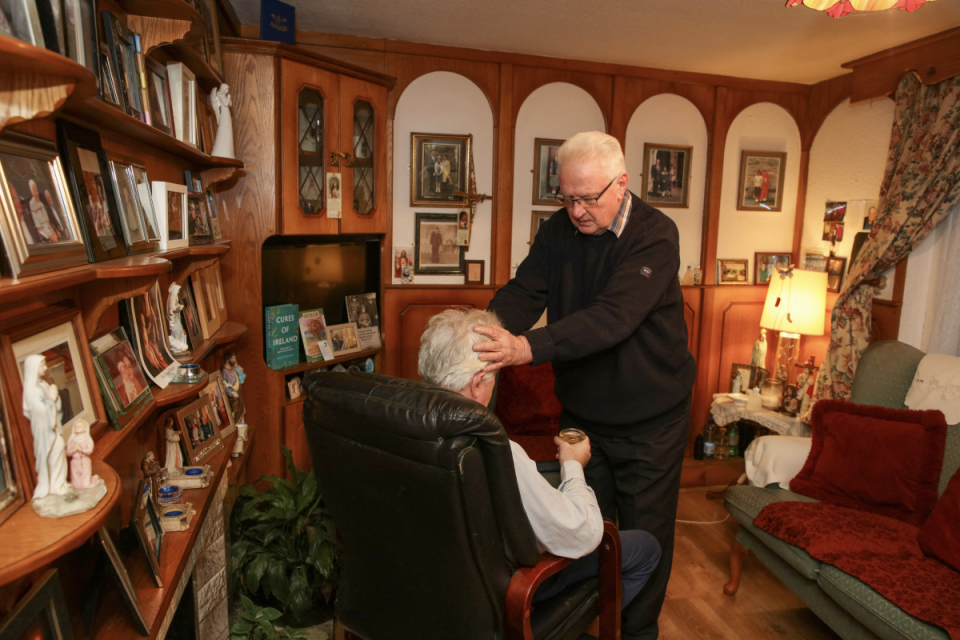
Traditional faith healer Joe Gallagher performs a faith healing ritual inside his living room attached to The Pull Inn
Kayley Hardiman: ‘Joe explained: “It’s something I’ve been doing since I was a baby. My parents used to take my hand and do it when I didn’t know I was doing it.” At around six or seven years of age, Joe knew how to make the sign of the cross and to say a prayer on the affected area of the person’s body but said he didn’t like curing people then as he didn’t understand it. “I would be called in when I would be out playing. That time ringworm was the big thing. As I got older I realised what it was all about.” “You don’t know what people are going to turn up with. I just do what I do and see how it goes.” The Leitrim native doesn’t charge clients for his services as he explained: “If I got a gift from God I didn’t pay for it so I don’t think it’d be right to charge for it so I hope my reward will be in the next world” – Article: DEATH: A Dead End or a New Beginning?
Joe also has very strong faith and was a Franciscan monk in his youth up until the age of 25, [as he was unable to work as a missionary abroad] based at monasteries in Clara and Galway from 1960 to 1971 when he left the Brothers and opened the pub in Pullough. He said that he “enjoyed every day” with the Brothers and that they were “lovely people.” Joe also performed cures for people while in the monastery. “Being a monk helped me with my faith,” he said. “I have a strong belief in God and in prayer, there’s nothing better than prayer.”
Joe highlighted that faith healers are a “dying breed” as people with his gift cannot pass it on. “When I pass away that’s it, it dies with me,” explained Joe. “There’s not seven in a family never mind seven sons (nowadays.) There’s nobody can afford to have seven children, and then it’s just by luck if you have seven sons. There’s only two or three in most families now but in my time they were all big families where I came from in north Leitrim.” Joe has eight children…’
Times of Malta: ‘A blurry black and white photo shows a row of six brothers with a smiling Gallagher the youngest – and last surviving – in the line. Another brother, Oliver, died in infancy. “When I was born, the parish priest called to see my mother and said to her, ‘This lad must have the cure, sure, isn’t he the seventh son?’ he said. To prove whether the infant Joe had “the cure”, a worm was placed in his hand, and promptly died. “From then on I’ve been doing the cures, long before I ever knew what I was doing, but as I grew up, I realised I had this gift, and had to do it,” he said. Gallagher doesn’t charge for his services but visitors can donate to a children’s hospital if they wish. Told never to refuse anybody, he was once asked to “do an exorcism” for a Polish man. “That was frightening, it’s not something I’d be happy to do too often,” he said. Inside the small living room where he receives visitors, religious items, crucifixes and vials of holy water look down from shelves.
After enquiring about the complaint, Gallagher places his hand on the affected area, rubs ointment and calls for divine help. “Heal this little baby,” he said, stroking the sole of an infant’s foot as the father held the child. “It’s only a little touch of rash,” he added soothingly. Gallagher asks visitors to pray themselves and return three Sundays in succession, which makes for a hectic schedule. “Sometimes people might have to come back more if it’s not cleared up, but there’s always an improvement,” he said, adding that he has no intention to retire. “I get a great feeling if somebody comes back to me and says, ‘That worked, Joe’, so why should I stop?”
Danny Gallagher:
Power in the palm of his hands, Una Brankin, February 12, 2014: ‘In his youth, Danny Gallagher [another Gallagher like his preceding namesake, Joe] looked like a cross between the Sixties folk singer Donovan and musical icon David Essex. His face is fleshier and ruddier these days but he has managed to keep the dark curls, although they’re not as thick on top now. For a down-to-earth no-frills Maghera [County Down, Northern Ireland] man, he’s amusingly reluctant to give away his age (I’d put him in his early 60s).’
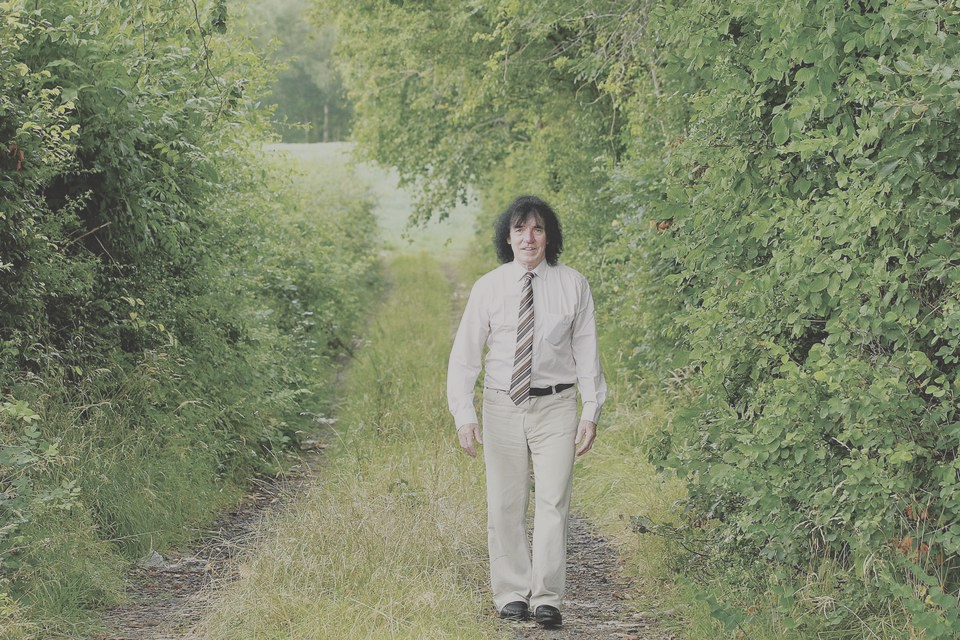
‘At the height of his international fame in the Eighties, the seventh son of a seventh son had the chance to make a pop star’s fortune when major promoters came knocking on his door. They’d heard the reports of his miraculous cures all over the world and saw the pound signs.
“The trouble was, they wanted to put me in these great big halls which would have meant the people would have been charged far too much to see me,” he recalls over coffee in Armagh’s City Hotel. “So I turned them all down. This is not something I do to make money. It’s to help people. I only make enough to cover my expenses. I usually only break even, but it’s important to use hotels because they are neutral; actual religion doesn’t come into my work, so using a parish hall or whatever wouldn’t be right.” He charges £25 per healing session, which usually take place in hotels. Taking in the cost of the hotel, advertising, insurance and transport, he reckons each gathering costs £5,000 to put on. He is incredibly busy working as a healer full-time and has no other source of income.
Much loved by those he has helped – many of whom have come to regard him as part of the family – his activities have, however, drawn the disapproval of the Advertising Standards Authority of Ireland (ASAI), specifically for, they say, the claim that he could treat “serious or prolonged ailments or conditions requiring the attention of a registered medical or other qualified practitioner”. According to the ASAI, a complainant said that: “Danny Gallagher had no medical qualifications and while no form of medical treatment was on offer, the advertiser nevertheless appeared to be making healing claims for serious illnesses.”
Danny is untroubled by the claim, though. “The complainant I think was some private doctor who I believe is jealous of my healing and tried to make it out it was not true,” he shrugs. “My healing is true; it’s backed up by testimonies. I don’t worry about that – it came to nothing at all. I asked the ASAI to come and meet the people who were healed and they would speak for themselves. They refused. It’s some stupid code that no-one understands.”
These testimonies are in their hundreds and they all cite a great heat coming from Danny’s hands when he touches them. Recent ones include 78-year-old Antrim woman, Martha Rea, who was blind from incurable degenerative eye disease until she started seeing Danny for healing, and Tipperary student, Laura Halloran, who suffered from Peripheral Neuropathy in her feet, nerve damage which left her in such agony she could hardly bear to walk to the toilet. “I was on 23 tablets a day, which did nothing for the pain,” Laura (26) told a… newspaper.
“I had to get injections for pain relief but when they wore off, I’d be in complete agony again. It was as if my feet were stuck in the fire. But the minute I met Danny, in Kildare, I knew immediately this man could help me. I met him three times in Athy and continued to have the pain until one night I slept – I couldn’t sleep properly before because the weight of a duvet or blankets on my feet was unbearable. The pain just disappeared and I was able to go to college, something that was impossible for me before meeting Danny.”
The day we meet, Danny has driven from his home in Maghera to the City Hotel in Armagh, where he often works. He arrives right on time and walks in brisk little strides to my table in the foyer. I’ve a habit of speaking quickly at times and he tells me not to be nervous, that he’s “an ordinary person”, just like me. He sits beside me on the sofa, insists on paying for the coffees, and leans in to chat – very openly and with good humour. I like him immediately.
So did Chris Tarrant when he met Danny while filming in Ireland in 2002, describing how he’d seen the “unassuming Irish man’s God-given talent” for himself at a healing event. Tarrant reported on the astonishing case of Fintona woman, Mary Mullan, who had been paralysed after suffering a seizure. At her second healing session with Danny, she was able to get out of her wheelchair and walk towards him.
According to ancient Celtic wisdom, the seventh son of a seventh son possesses the power to heal people by simply touching them. The origin of the legend is unclear, but it was common during the 17th century in England and according to the Encyclopedia of Folk Medicine, this idea of the seventh of the seventh being a healer is widespread among many cultures. Danny’s father, Michael Gallagher from Draperstown, survived the Battle of the Somme in WWI and won several medals for bravery in the conflict. A private man and hardworking labourer all his life, Michael never spoke about the war. Danny also values his privacy and prefers to keep his wife Nora and family out of the limelight. And like his father, he never spoke during his childhood of the experience that would change his life forever.
He was only eight when he had an extraordinarily vivid dream about curing a young girl, in which he was given a prayer to say for the sick. He told no-one and made no attempt to heal anyone for many years after his vision, until he finished school and bought himself an ice-cream van. One of his regulars was a tiny crippled girl for whom he always saved a free ice-cream. He laid his hands on the girl in the manner revealed to him as a child, said the prayer (which he keeps private) and the girl began to regain the power of her legs. The story of the cure was reported by the local newspaper and Danny’s life was changed for good. He obtained an immediate following locally, where the tradition of – if not necessarily the belief in – the powers of the seventh son is deep-rooted through generations.’
Steven Moore, 2023: ‘… Danny reveals: “I was very ill as a young boy… I was sick all the time from the age of about five to the age of 13. I was never out of hospital, particularly the Mid-Ulster in Magherafelt. It was my second home but I also ended up in the Royal (Victoria Hospital) too. One particular illness which was bad was pneumonia and then pleurisy which was very serious. I ended up having more operations than I care to remember. I had to get skin grafts from my leg to cover my wounds from operations. I still have the scars today from the grafts taken from my two legs. Doctors told my mother I would not survive. My mother brought me home because she wanted me to pass away at home and not in hospital”… he remembers coming close to death.
“I remember the priest by my bedside [reading the last rites] and my mother telling me not to worry, that the angels would come through the ceiling and take me with them.”
Brankin: ‘As people began to claim more cures, the national media began to take notice, at first concentrating efforts on exposing him as a fraud, later supporting him with exclusive accounts. Hundreds of letters and telephone calls were now coming daily from England. He eventually decided to take the boat across to England [as Valentine Greatrakes before him], but what he initially intended as a national tour came to an abrupt halt in the industrial heartland around Birmingham, because of the great demand there for his services. One cure in the Midlands did more to enhance Danny’s reputation than anything before. Jean Prichett, then a 40-year-old housewife, had been blind for 22 years from what was diagnosed as Retinitis Pigmentosa. She had visited specialists all over Britain without finding help. Her cure caused an immediate sensation in the popular press, attaining front page headlines in the News Of The World on October 31, 1976. The medical profession was immediately critical. One specialist expressed the opinion that Mrs Pritchett suffered from a case of hysterical blindness which was probably brought on by the psychological technique of autosuggestion.
But the Pritchett ‘miracle’ was followed a month later by Gallagher’s equally remarkable cure of Kathleen Bailey from the village of Dawley, near Shrewsbury, in England. Mrs Bailey, a 29-year-old mother-of-three, had been confined to a wheelchair after a spinal injury at work 11 years before. The condition did not respond to medical treatment and grew progressively worse. “I was virtually a cripple,” Mrs Bailey told the Shropshire Star on December 9, 1976. “I could not do anything.” Friends and relatives persuaded her to visit Gallagher at his clinic in Erdington, Birmingham. After treatment by the healer she was able to leave her wheelchair. A remarkable photograph of her in an article in the Shropshire Star, shows her bending to touch her toes, and a consultant at the Shropshire Orthopedic Hospital at Gobowen, a small town near the Welsh border, described her recovery as “incredibly dramatic.” Danny stresses, however, that he does not cure everyone, and strongly advises those he sees not to stop taking any form of medication or treatment.
“Not even Jesus cured everyone who came to him,” he says [though not because he couldn’t but rather, it just wasn’t feasible when many thousands of people flocked to listen to him]. “I don’t feel any different to anybody else. “I never asked to be a healer, it just happened. I can’t explain it.” Does a person have to believe in God and divine healing in order to be cured? “No,” replies Danny. “I’ve been able to help non-believers, the blind English girl never had been in a church in her life. And then there’s babies. They don’t believe in anything and still some of them are cured. The blind girl came over to see me a while after and she loved driving through the countryside. I asked her what was the nicest thing she saw and she said, ‘A leaf falling off a tree’. “It’s the simple things that have the power in them. I’ve clergy on both sides and nuns coming to see me all the time with all sorts of problems. Even the doctors now are more supportive. I’m very lucky with the world’s media too. Once they caught on I was genuine, they were very positive in their reports.”
Back in 2002, when Deportivo La Coruna defender, Aldo Duscher, broke David Beckham’s foot, Mr Gallagher offered to help heal the former Manchester United winger. Beckham reportedly asked Danny to be put on standby to treat the injury, as it was feared that the damage to his foot would not be receptive enough to medical treatment in time for the World Cup in South Korea and Japan. Danny proudly shows me the letter of thanks on Manchester United headed paper, and another from the late Queen Mother’s private secretary, thanking him for his offer to help her when she was unwell, and assuring him she was feeling much better. He also shows me newspaper coverage of his cures in Kenya, Holland, Australia, Washington, New York, Singapore, India, Pakistan and Turkey, as well as emails from three doctors, from London, Letterkenny and the famously expensive private Blackrock Clinic in Dublin, asking for his help with personal medical issues they couldn’t treat with conventional medicine. There are also dozens of letters from delighted people citing cures from depression, paralysis, eczema, anorexia and psoriasis.
Such is his reputation for healing, a RTE radio team recently followed Danny around for a week for a documentary on his work, while he will also feature in a major upcoming History Channel series, Miracles Decoded, which airs this June. A typical working day for him begins with replying to emails, which can take an hour or two, depending on the requests. Some enquire if he is returning to hold clinics abroad so that they can visit him in their own country. Others ask him to visit hospitals, some of whom are seeking absent healing. Then it’s off to his healing centres across the country, from his clinics in Maghera and Cavan to hotels such as the Clanree in Letterkenny, where he sets up signs to direct people to the room he’s in. He sees people individually from 2-8.30pm, “sometimes with no breaks in between”.
“I am so exhausted when I get back to my room sometimes I could sleep on a chair watching the news on television. I’ll get up around 7am and go down for breakfast at a quiet table, hoping no-one will come over to my table and start telling me their problems before I have time to butter my toast! If I am lucky, no-one bothers me, although I couldn’t ignore anyone who might appear. Then I head to the next city and do the same thing all over again. “Sometimes the healing works and sometimes not. It can be very stressful – travelling, taking phone calls and listening to everyone’s problems, some very disturbing, such as boys and girls who have been abused by a family member or close relative from a very young age. The suffering they came through can be very disturbing.”
One of the most disturbing encounters he’s had recently was in Washington, with young American soldiers badly injured in Iraq. “They were only babies those fellas. Babies in their teens. One was in a deep coma with half the head blown off him. I took his hand and he squeezed my hand. All I could do was touch his head and pray for him; I don’t know if he survived.
“It’s not all bad though. I met a 90-year-old the other day who could hardly walk and when I touched her she said it was years since anyone had felt her leg! You get a good laugh sometimes.”
Next stop for this warm, humble man is a trip to Russia, where he has been invited for healing. As he walks me to the car outside the hotel, he remarks for the second time, with a look of concern on his face, that I look tired, and says he will say a prayer. Then he scurries to his car boot and gives me seven small candles he uses in his healing, to light for each day of the week, and a card with [his] healing prayer on it. I go home and forget all about the candles, but I’ve kept the prayer card in my purse, just in case…’
Irish Central, October 5, 2022: ‘It was reported by the Sunday World that Gallagher recently came out of retirement to help a baby girl from Belfast who was brought to him with heart issues.’ Moore: ‘It was the story of little Co Antrim baby Maia Mhandu who was born with four holes in her heart. Her desperate parents, one of who is a leading surgical doctor at the Royal Victoria Hospital, approached Danny as a last resort. Doctors treating Maia told her parents when she was born she could suffer heart failure and die at any moment and she’d at the very best need several invasive operations and strong medication to save her life. When Maia’s parents became so afraid to sleep in case Maia didn’t wake up, they took drastic action and sought the help of Danny. And after a few visits the holes in her heart – including a massive one in her small chamber – closed over and scans at her six-month review proved it.’
Irish Central: “We visited him and he did the blessing always after sunset but even after the first visit we saw big improvements,” her mother explained “She started feeding better, putting on weight and getting stronger, she just had more energy and she just kept improving.” Moore: ‘Her mum Emma… : “We remain forever grateful to Danny. He was very honest with us from the start. He told us there was no guarantee and he was insistent that we keep up all our hospital appointments. “He wasn’t promising anything and definitely wasn’t saying we should ignore the advice of the hospital, quite the opposite. “It was fantastic being able to celebrate her first birthday in September. There were moments when we feared she would ever get to celebrate that.” Irish central: “The only thing I can call it is a miracle. I have no idea how it happened or why it happened but it happened.”
‘… Danny reveals how he was a reluctant healer and how he still has no idea how it works. “As a small boy my mother kept telling me I would be a healer one day,” he says.’
The persistent and prevalent folklore surrounding a seventh child in Scotland and especially Ireland, has its roots in the Bible. The identity of the Scots and Irish has been fully documented for those newer readers wishing to delve deeper into the secular, biblical and genetic evidence – refer Chapter XXX Judah & Benjamin – the Regal Tribes; and Chapter XXXI Reuben, Simeon, Levi & Gad – the Celtic Tribes.
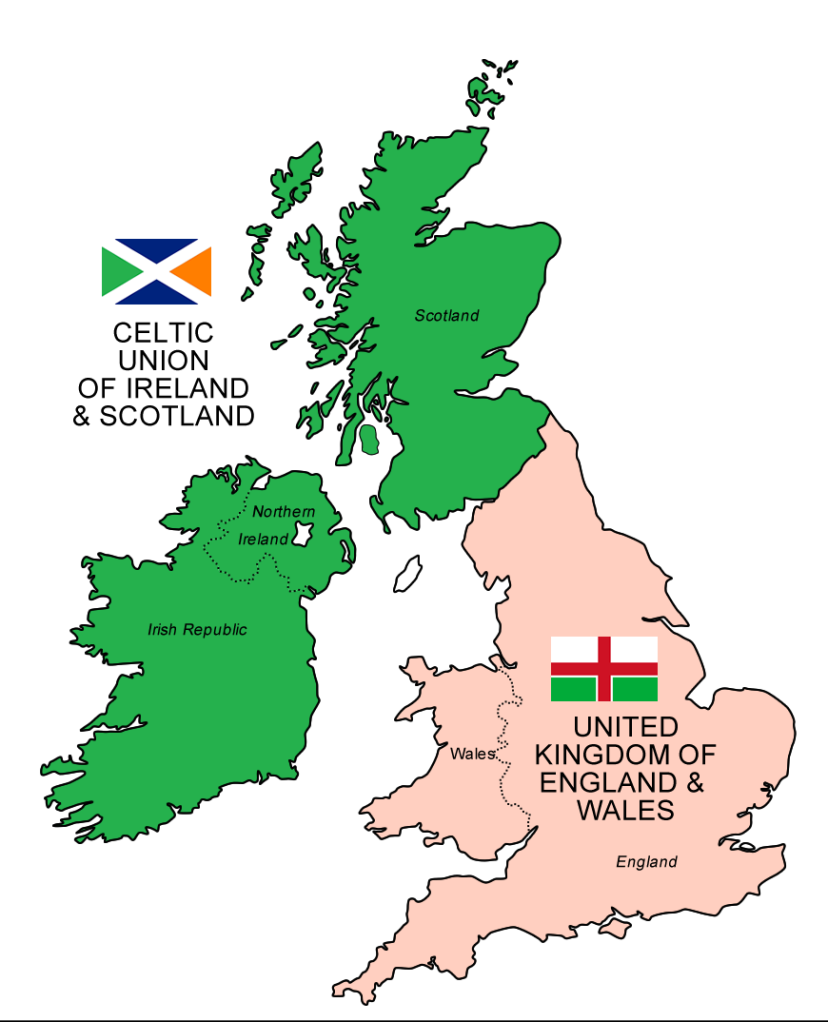
Map of Scotland, Ireland and Northern Ireland and a hypothetical union in the future of the descendants of Benjamin, Gad and Reuben.
The Patriarch Jacob had twelve sons. Only two of them had seven sons or more. They were Jacob’s youngest and twelfth son, Benjamin – born to Jacob’s second wife Rachel – who had ten sons of his own; and his first son born to Leah’s maidservant, Zilpah. His name was Gad and he was Jacob’s seventh son. Gad in turn, had seven sons of his own.
It is then an uncanny coincidence that it is these two sons of Jacob, each with seven sons or more, who are the progenitors of the people in Scotland and Ireland respectively.
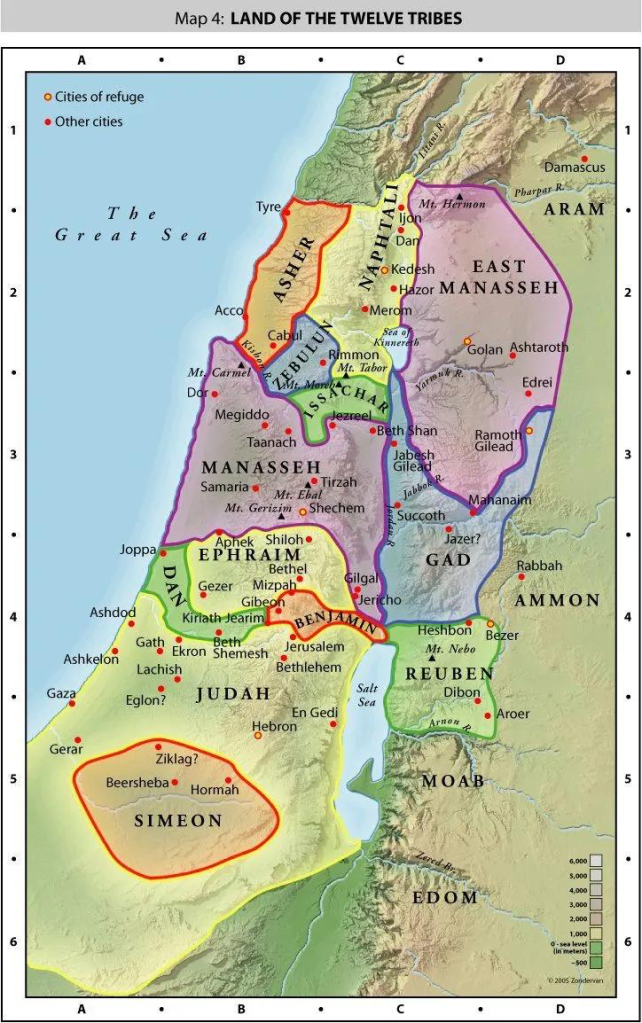
The original allotment of land for the twelve sons of Jacob. Note the geographic proximity between the tribes of Benjamin and Gad – then as well as today.
Famous and well known people from the tribe of Benjamin in the scriptures include, a. Ehud, second Judge of Israel; b. Saul, first king of Israel ; c. Mordecai; d. Esther; and e. the ‘Apostle’ Paul (Article: The Pauline Paradox).
Benjamin’s name in Hebrew means: Son of the Right Hand. ‘From (1) the noun (ben), son, and (2) the noun (yamin), right hand.’ This was not Benjamin’s original name.
Genesis 35:16-19
English Standard Version
‘Then they journeyed from Bethel. When they were still some distance from Ephrath, Rachel went into labor, and she had hard labor. And when her labor was at its hardest, the midwife said to her, “Do not fear, for you have another son.” And as her soul was departing (for she was dying), she called his name Ben-oni; but his father called him Benjamin. So Rachel died, and she was buried on the way to Ephrath (that is, Bethlehem)…’
Book of Jubilees 32:33-34
‘And Rachel bare a son in the night, and called his name ‘Son of my sorrow’; for she suffered in giving him birth: but his father called his name Benjamin, on the eleventh of the eighth month [October/November, circa 1699 BCE]… And Rachel died there and she was buried in the land of Ephrath, the same is Bethlehem, and Jacob built a pillar on the grave of Rachel, on the road above her grave.’
There are three men named Benjamin in the Bible, with Jacob’s son being the most famous. The other two men named are, 1. a descendant of the original Benjamin, namely a son of Bilhan, son of Jediael – 1 Chronicles 7:10; and 2. a son of Harim, ‘who had married and probably divorced a foreign woman during the purge of Ezra – Ezra 10:32.’
A number of chief families are listed amongst the exiles returning from Babylon, from the tribes of Judah, Benjamin and Levi. Included are families listed as Israel. Whether this means a remnant from all the tribes, or just not from Judah and Levi, meaning from Benjamin is not clear. If it was Benjamin, then Harim in verse 32 – not the same as Harim of the priesthood in verse 21 – may have been from the tribe of Benjamin and hence his son called Benjamin too. The same as the other two Benjamins recorded in the Bible. Of these families, four had seven or more sons. Including Harim, who had eight sons, with Benjamin being number six and Malluch, the seventh son.
Ezra 10:25-35
English Standard Version
‘And… of the sons of Parosh: Ramiah, Izziah, Malchijah, Mijamin, Eleazar, Hashabiah, and Benaiah [built up of the Lord]…
Of the sons of Pahath-moab: Adna, Chelal, Benaiah, Maaseiah, Mattaniah, Bezalel, Binnui [built], and Manasseh.
Of the sons of Harim: Eliezer, Isshijah, Malchijah, Shemaiah, Shimeon, Benjamin, Malluch, and Shemariah.
Of the sons of Hashum: Mattenai, Mattattah, Zabad, Eliphelet, Jeremai, Manasseh, and Shimei* [renown, famous].’
The thread of commonality between the meanings of the names of these seventh sons is interesting as is the meaning of Malluch in particular, which means reigning and stems from the verb malak, ‘to be or become king.’
The sons and early descendants of Benjamin are listed in three places.
Genesis 46:21
English Standard Version
‘And the sons of Benjamin: Bela [1], Becher [family name of Ephraim], Ashbel, Gera, Naaman, Ehi, Rosh [7], Muppim, Huppim, and Ard [10].’
Numbers 26:38-41
English Standard Version
‘The sons of Benjamin according to their clans: of Bela, the clan of the Belaites; of Ashbel, the clan of the Ashbelites; of Ahiram, the clan of the Ahiramites; of Shephupham, the clan of the Shuphamites; of Hupham, the clan of the Huphamites And the sons of Bela were Ard and Naaman: of Ard, the clan of the Ardites; of Naaman, the clan of the Naamites. These are the sons of Benjamin according to their clans, and those listed were 45,600.’
1 Chronicles 7:6-12
English Standard Version
‘The sons of Benjamin: Bela, Becher, and Jediael, three.
The sons of Bela: Ezbon, Uzzi, Uzziel, Jerimoth, and Iri, five, heads of fathers’ houses, mighty warriors. And their enrollment by genealogies was 22,034.
The sons of Becher: Zemirah, Joash, Eliezer, Elioenai, Omri, Jeremoth, Abijah [7], Anathoth, and Alemeth.
All these were the sons of Becher. And their enrollment by genealogies, according to their generations, as heads of their fathers’ houses, mighty warriors, was 20,200.
The son of Jediael: Bilhan. And the sons of Bilhan: Jeush [family name of Esau], Benjamin, Ehud, Chenaanah, Zethan, Tarshish [family name of Javan], and Ahishahar [7].
All these were the sons of Jediael according to the heads of their fathers’ houses, mighty warriors, 17,200, able to go to war. And Shuppim and Huppim were the sons of Ir, Hushim the son of Aher.’
Abijah means: ‘Yah Is (My) Father’ and Ahishahar, ominously means: brother of darkness or dark brother.
In 1 Chronicles chapter eight, the genealogy of Israel’s first king is recorded.
1 Chronicles 8:1-34
English Standard Version
‘Benjamin fathered Bela his firstborn, Ashbel the second, Aharah the third, Nohah the fourth, and Rapha the fifth. And Bela had sons: Addar, Gera [?], Abihud, Abishua, Naaman, Ahoah, Gera [7], Shephuphan [7a?], and Huram.
And Shaharaim fathered sons in the country of Moab after he had sent away Hushim and Baara his wives. He fathered sons by Hodesh his wife: Jobab, Zibia, Mesha, Malcam, Jeuz, Sachia, and Mirmah [7].
These were his sons, heads of fathers’ houses. He also fathered sons by Hushim: Abitub and Elpaal. The sons of Elpaal: Eber, Misham, and Shemed… and Beriah and Shema… and Ahio, Shashak [7], and Jeremoth. Zebadiah, Meshullam, Hizki, Heber, Ishmerai, Izliah, and Jobab [7] were the sons of Elpaal.
Jakim, Zichri, Zabdi, Elienai, Zillethai, Eliel, Adaiah [7], Beraiah, and Shimrath were the sons of Shimei.*’
Ishpan, Eber, Eliel, Abdon, Zichri, Hanan, Hananiah [7], Elam, Anthothijah, Iphdeiah, and Penuel were the sons of Shashak. These were the heads of fathers’ houses, according to their generations, chief men. These lived in Jerusalem.
Jeiel the father of Gibeon lived in Gibeon, and the name of his wife was Maacah. His firstborn son: Abdon, then Zur, Kish, Baal, Nadab, Gedor, Ahio [7], Zecher, and Mikloth (he fathered Shimeah). Now these also lived opposite their kinsmen in Jerusalem, with their kinsmen.
Ner was the father of Kish, Kish of Saul, Saul of Jonathan, Malchi-shua, Abinadab and Eshbaal; and the son of Jonathan was Merib-baal; and Merib-baal was the father of Micah.’
Gera or Gerar means: ‘dragging’ or ‘sojourning.’ The first Gera may have died and hence the second Gera may have been the sixth son. Placing Shephuphan as the seventh son instead. His name menacingly means: burrowing snake or serpent; Mirmah means: deceit or treachery; Jobab means: ‘to call’ or ‘cry shrilly’; and Ahio means: ‘brotherly’ or ‘brother of Yah’. Adaiah’s name has unique meanings: ‘Ornament of the Lord’, ‘Yahweh has adorned’ and ‘Yah has decked himself.’
In the main, the definitions are positive, though some stand out as dark and may indicate seventh sons who were evil. All in all, there are a number of families with seven sons, as larger families were the norm.
The first confirmed seventh son of a seventh son, is Hananiah. Which means: ‘Yah has been gracious’, who was the seventh son of Shashak. His name meaning: babel or six (666); the son of Elpaal- meaning: ‘God has wrought.’
Genesis lists ten sons; Numbers lists five sons; I Chronicles seven lists three sons and chapter eight which includes Saul’s genealogy, unhelpfully lists five sons. Even if one assumes the change from five to three was due to the Israelite civil war against Benjamin – it doesn’t explain the drop from ten to five in the first place – and if the six hundred men remaining were from Bela, Becher and Jediel, apart from Bela the one consistent son, the firstborn in all four references, Becher is missing from the second and fourth references and Jediel is only mentioned once, unless he is Ashbel. Even Muppim seems to have turned into Shuppim.
Added to this are the two lists of sons of seven from Elpaal. Either he had two wives, or there were two Elpaals in the family tree of Saul. The answer overall may lay with Benjamin having more than one wife. A connection between seventh son Rosh and the clan name Ros-s is possible, as is Ard-encaple with Benjamin’s tenth son, Ard. Rosh means ‘head, chief’ or ‘top’ – refer Chapter X China: Magog, Tubal & Meshech. Interestingly, the name Ross, means: ‘up-land peninsula’, ‘promontory head-land’, ‘cape’, ‘elder’ and may also be derived from the Gaelic word for ‘red.’
Before we study Gad, we learn the following about his half brother, Simeon’s descendants – the Welsh. 1 Chronicles 4:24-25, ESV: ‘The sons of Simeon: Nemuel, Jamin, Jarib, Zerah, Shaul; Shallum was his son, Mibsam his son, Mishma his son. The sons of Mishma: Hammuel his son, Zaccur his son, Shimei his son.’
Another son named Shimei as in the tribe of Benjamin. The name was a popular family name, for there was also a Shimei in Reuben’s family tree, in Levi’s and also a descendant of David of Judah – 1 Chronicles 5:4; 6:17. Shimei of Judah was the brother of Zerubbabel – 1 Chronicles 3:19. The Shimei from Simeon ‘… had sixteen sons and six daughters; but his brothers did not have many children, nor did all their clan multiply like the men of Judah’ – verse 27. It is possible that this Shimei from Simeon with sixteen sons, may have had an unbroken consecutive line of seven sons.
Continuing, Chronicle’s lists: ‘Elioenai, Jaakobah, Jeshohaiah, Asaiah, Adiel, Jesimiel, Benaiah [7], Ziza the son of Shiphi, son of Allon, son of Jedaiah, son of Shimri, son of Shemaiah – these mentioned by name were princes in their clans, and their fathers’ houses increased greatly – verses 36-38.
Seventh son Benaiah has the same name as the Benjamite seventh son of the returning exile from Babylon to Judea, Parosh. Included in King David’s descendants – tellingly as we shall discover – through his son Solomon’s line, was a man called Elioenai; meaning, ‘towards the Lord are my eyes’, who had seven sons. His seventh son was named Anani, meaning: ‘my obscurity, my cloud’ and ‘cloud of the Lord’ – 1 Chronicles 3:24.
Apart from Benjamin and possibly Simeon, evidence of seventh sons of seventh sons is scant amongst the sons of Jacob in the scriptures. Which leaves the tribe of Gad, where one does not need to hunt for an example, as it is leaps out from the pages of the Bible.
It is worth noting that Jacob’s uncle, Ishmael had twelve sons. His seventh son was called Massa, meaning ‘to lift up’ or an ‘oracle’ – Genesis 25:13-16. Refer Chapter XXVIII The True Identity & Origin of Germans & Austrians – Ishmael & Hagar.
Another relation, the elder brother of Abraham, Nahor also had twelve sons. He had eight sons with his wife Milcah who was Abraham’s niece – Genesis 11:29. The seventh son was called Jidlaph, meaning ‘he drips’ and ‘he weeps‘ – Genesis 22:20-24. Refer Chapter XXV Italy: Nahor & the Chaldeans.
A further example is the patriarch Job, a distant relative of Jacob and a contemporary of Moses. Job had seven sons and three daughters – Job 1:2. We are not told the names of his sons, or what order his ten children were born – Article: Job.
Outside of Jacob’s family, there are only two other examples of seventh sons in the Table of Nations in Genesis chapter ten. The first are the seven sons of Japheth, where the seventh is Tiras; his name meaning ‘desire, moisten’ – Genesis 10:2. Refer Chapter III Tiras the Amerindian.
The second is a descendant of Shem called Joktan, who had thirteen sons – Genesis 10:26-29. The seventh was called Diklah, meaning ‘palm tree’ – refer Chapter XXIV Arphaxad & Joktan: Balts, Slavs & the Balkans.
Abarim Publications:
There are two or three Gads mentioned in the Bible:
- The famous Gad [born in 1744 BCE] is the seventh son of Jacob and the first son of Zilpah, Leah’s maid (Genesis 30:11).
- The lesser known human Gad is a prophet in the time of David (1 Samuel 22:5).
- In Isaiah 65:11 the prophet seems to refer to an idol named Gad (also see the name Baal-gad) apparently in conjunction with the god Meni.
Gad’s name derives from the verb gadad, ‘to cut, invade’ and ‘expose.’
Abarim: ‘The name Gad indicates a fortune for which a troublesome, invasive effort is made. There are plenty of words to indicate treasure or felicity, but Leah who named the son of her maid, chose this painful word גד, Gad. Perhaps the reason for this is that she gave Zilpah to Jacob only because she could not conceive anymore. In those days, that was pretty awful, even though she had already given her husband four sons. The name Gad tells of a wife’s deep anguish, shame and loneliness.
For the meaning of Gad, the NOBSE Study Bible Name List reads Good Fortune. Jones’ Dictionary of Old Testament Proper Names has the same, but adds Good Luck. A more accurate translation would be Harrowing Fortune.’ Everyone has heard of “the luck of the Irish.”
Genesis 46:16
English Standard version
‘The sons of Gad: Ziphion [hidden], Haggi [festive], Shuni [silence], Ezbon [understand], Eri [focused], Arodi [fugitive], and Areli [7].’
Gad himself a seventh son, had seven sons. His seventh son was named Areli. His name stands out from his brothers, who all have relatively straight forward meanings. Whereas Areli means: ‘gathered by God, Lion of my God, valiant’ and ‘heroic.’
Perhaps Areli was a significant presence as a seventh son of a seventh son.

Areli: the seventh son of Gad
Gad’s fifth son Eri, has an etymological link with the names Eri-n and Ire-land, as well as the islands of Aran. Erin is the 41st most common girls name in Ireland out of 101 names – as of February 2024.
The Book of Numbers includes the main clans of Gad at the time of the census after the trek through the wilderness – Appendix VII: Moses, the Exodus & the Dead Sea Crossing – Fabrication or Fact?
Numbers 26:15-18
English Standard Version
‘The sons of Gad according to their clans: of Zephon, the clan of the Zephonites; of Haggi, the clan of the Haggites; of Shuni, the clan of the Shunites; of Ozni, the clan of the Oznites; of Eri, the clan of the Erites; of Arod, the clan of the Arodites; of Areli, the clan of the Arelites. These are the clans of the sons of Gad as they were listed, 40,500.’
We learn that Areli had children and perhaps a seventh son of his own? In 1 Chronicles, further information regarding Gad’s descendants is provided.
1 Chronicles 5:11-13
English Standard Version
‘The sons of Gad lived over… in the land of Bashan as far as Salecah: Joel the chief, Shapham the second, Janai, and Shaphat in Bashan. And their kinsmen according to their fathers’ houses:
Michael, Meshullam, Sheba, Jorai, Jacan, Zia and Eber [7], seven.
These were the sons of Abihail the son of Huri, son of Jaroah, son of Gilead, son of Michael, son of Jeshishai, son of Jahdo, son of Buz.’ Michael is the 15th most common boys name in Ireland out of 102 names – as of February 2024.
‘Ahi the son of Abdiel, son of Guni, was chief in their fathers’ houses, and they lived in Gilead, in Bashan and in its towns, and in all the pasturelands of Sharon to their limits. All of these were recorded in genealogies in the days of Jotham king of Judah [who reigned from 749 to 733 BCE], and in the days of Jeroboam [II, who reigned from 793 to 753 BCE] king of Israel.’
The final seventh son of a seventh son is identified as Eber, the son of Abihail. Eber means: ‘the region beyond, one from beyond, from the other side’ and ‘he who passed over.’ While these definitions are understood to be from a physical perspective for the original Eber – Genesis 10:24 – for this Eber, there may have been a spiritual application as a seventh son of a seventh son.
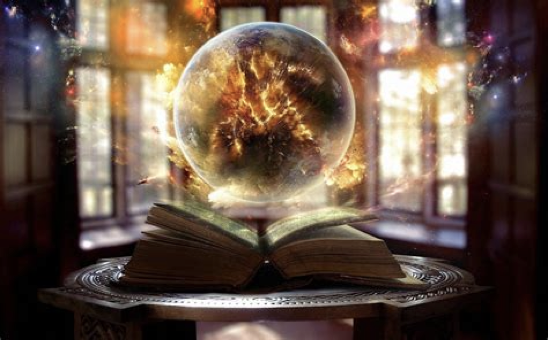
Eber was a common family name and for example, recall the same name of the son of Elpaal of Benjamin, as well as the son of Shashak. From the Hebrew word Eber, has derived the following names: Hebrew, Iberia and Hibernia.
The mystique of Ireland and their ancient Patriarchal ancestor Gad is reflected in the non-canonical work, The Book of Gad the Seer, mentioned in the Bible – 1 Chronicles 29:29. As is the preoccupation with seven sons in the 1954 motion picture, Seven Brides for Seven Brothers. Aside note of interest for the constant reader: all seven brothers had red hair – Chapter I Noah Antecessor Nulla and Chapter XXIX Esau: The Thirteenth Tribe.

There is one final example of perhaps the most famous seventh son of a seventh son of all and he also is to be found in the scriptures.
We begin with the young man in the Bible called David. Readers interested in added detail about David and his life are encouraged to read Chapter XXX Judah & Benjamin – the Regal Tribes. Picking up with David in the year 1022 BCE when he was seventeen years of age. The Eternal has directed the prophet and priest Samuel, to anoint a new king, for King Saul had fallen out of favour. Samuel arranges a meeting with a man from the tribe of Judah called Jesse and his sons.
1 Samuel 16:6-13
English Standard Version
‘When they came, he looked on Eliab [1] and thought, “Surely the Lord’s anointed is before him.” But the Lord said to Samuel, “Do not look on his appearance or on the height of his stature, because I have rejected him. For the Lord sees not as man sees: man looks on the outward appearance, but the Lord looks on the heart” [Jeremiah 17:9, Isaiah 66:2] Then Jesse called Abinadab [2] and made him pass before Samuel. And he said, “Neither has the Lord chosen this one.” Then Jesse made Shammah [3] pass by. And he said, “Neither has the Lord chosen this one.” And Jesse made seven of his sons pass before Samuel. And Samuel said to Jesse, “The Lord has not chosen these.”
Then Samuel said to Jesse, “Are all your sons here?” And he said, “There remains yet the youngest, but behold, he is keeping the sheep.” And Samuel said to Jesse, “Send and get him, for we will not sit down till he comes here.” And he sent and brought him in. Now he was ruddy and had beautiful eyes and was handsome. And the Lord said, “Arise, anoint him, for this is he.” Then Samuel took the horn of oil and anointed him in the midst of his brothers. And the Spirit of the Lord rushed upon David from that day forward…’
Samuel understandably, was struck by the impressive height and looks – with regard to stature and muscles – of David’s brothers. All seven passed by Samuel, though the Eternal did not choose any of them. David had not been deemed worthy enough by his father Jesse, to bring to such an important and historic event perhaps. Thus everyone had to wait until David was found herding the families sheep, freshened up and brought before Samuel. David was different and not especially close with his family – Psalm 38:11. Or it merely may have been that Jesse, who was very old at the time, felt a seventeen year old could not surely be in the running to be the next king.
This passage alludes to David being the eighth son of Jesse. And while David was a very handsome man, with a fair complexion and red hair, he was not as tall or imposing as his impressive brothers. Between this event and David’s confrontation with the Philistine giant Goliath, David worked for King Saul part time playing music, while still herding sheep for his father. David’s three eldest brothers mentioned in the previous passage were all in Saul’s army.
1 Samuel 17:12-18
English Standard Version
‘Now David was the son of an Ephrathite of Bethlehem in Judah, named Jesse, who had eight sons. In the days of Saul the man was already old and advanced in years. The three oldest sons of Jesse had followed Saul to the battle. And the names of his three sons who went to the battle were Eliab the firstborn, and next to him Abinadab, and the third Shammah [3]. David was the youngest. The three eldest followed Saul, but David went back and forth from Saul to feed his father’s sheep at Bethlehem.
For forty days the Philistine [giant called Goliath] came forward and took his stand, morning and evening. And Jesse said to David his son, “Take for your brothers an ephah of this parched grain, and these ten loaves, and carry them quickly to the camp to your brothers. Also take these ten cheeses to the commander of their thousand. See if your brothers are well, and bring some token from them.”
Again, the account records that Jesse had eight sons, with David being the eighth and youngest son. Yet in the later Book of Chronicles there is a perplexing omission in the genealogy of David.
1 Chronicles 2:3-16
English Standard Version
‘The sons of Judah: Er, Onan and Shelah; these three Bath-shua the Canaanite bore to him… His daughter-in-law Tamar also bore him Perez and Zerah. Judah had five sons in all. The sons of Perez: Hezron and Hamul. The sons of Zerah: Zimri, Ethan, Heman, Calcol, and Dara, five in all…
The sons of Hezron that were born to him: Jerahmeel, Ram, and Chelubai. Ram fathered Amminadab, and Amminadab fathered Nahshon, prince of the sons of Judah. Nahshon fathered Salmon, Salmon fathered Boaz, Boaz fathered Obed, Obed fathered Jesse.
Jesse fathered Eliab his firstborn, Abinadab the second, Shimea the third, Nethanel the fourth, Raddai the fifth, Ozem the sixth, David the seventh.
And their sisters were Zeruiah and Abigail…’
Here we learn that David is now the seventh son. The account clearly lists seven brothers with Eliab the firstborn and David now the seventh born son and importantly seventh born sibling, implying his sisters were younger. As this is obviously not a slip of the scribal pen, it means an older brother of David has been omitted. The question then, is why?
We read twice that the third child of Jesse was a male named Shammah, meaning at its worst: ‘waste, appalling desolation’ and at its best, ‘astonishment.’ This name has terrible significance and as Abarim note, Shammah ‘is an example of a name that probably didn’t have the function of reflecting qualities of the bearer but rather to commemorate a certain event that had nothing to do with the bearer, and at best coincided with his birth.’ I would add, maybe it had something to do with his death. Perhaps Shammah suffered a brutal demise while a soldier in Saul’s army.
Some equate Shimea and Shammah as the same person. Though their names have entirely different meanings, ruling this theory out. Shimea means: ‘He (God) has heard, hearing’ and ‘rumour.’ Either way, David began as the eighth son and sibling out of ten, to then legitimately become the seventh son and seventh sibling out of a resulting nine in total. There is reason to believe that the name David was in fact a title, meaning: a ‘beloved chieftain.’ Whereas David’s true name, was Elhanan, meaning ‘God has been gracious.’ It was a man called Elhanan, who had defeated Goliath.
David had a colourful love life and an eye for the ladies. He was charismatic, good looking and popular. In the Book of Chronicles, many of David’s numerous children from a number of wives are enumerated.
1 Chronicles 3:1-9
English Standard Version
‘These are the sons of David who were born to him in Hebron: the firstborn, Amnon, by Ahinoam the Jezreelite [in the territory of Issachar]; the second, Daniel [Kileab], by Abigail the Carmelite, the third, Absalom, whose mother was Maacah, the daughter of Talmai, king of Geshur [an Aramaean kingdom]; the fourth, Adonijah, whose mother was Haggith; the fifth, Shephatiah, by Abital; the sixth, Ithream, by his wife Eglah; six were born to him in Hebron, where he reigned for seven years and six months.’
This period was between Saul’s death when David ruled from the city of Hebron and winning a war against Saul’s son Ish-Bosheth; which made David Israel’s undisputed king.
‘And he reigned thirty-three years in Jerusalem. These were born to him in Jerusalem:
Shimea, Shobab, Nathan and Solomon, four by Bath-shua, the daughter of Ammiel;
then Ibhar, Elishama, Eliphelet, Nogah, Nepheg, Japhia, Elishama, Eliada, and Eliphelet, nine.
All these were David’s sons, besides the sons of the concubines, and Tamar was their sister.’
King David had six sons from six wives when living and ruling in Hebron. There, it abruptly and tantalisingly stops on a cliffhanger. Where we wonder who is number seven? David then proceeds to have at least thirteen more sons and a daughter, with at least eight wives. David possibly ‘inherited’ more wives of Saul – as was the custom – where the sons are listed without mothers named. This does not include the additional sons from concubines who are not listed in the kingly succession.
A son of David named Jerimoth is mentioned in 2 Chronicles 11:18; though it’s not clear whether he is one of the sons mentioned above, using another name, or if he was one of David’s sons by a concubine. Regarding three of David’s first six sons, Antonakis Maritis lists the key points:
Amnon: David’s firstborn by his wife Ahinoam was a man of low character and driven by lust. He became obsessed with his half-sister Tamar (daughter of Maakah) and lured her to his room on false pretenses so he could rape her. He was later murdered in revenge by Tamar’s full brother, Absalom (2 Samuel 13).
Absalom: Third in line, Absalom is one of David’s most notorious sons. A son of David’s wife Maakah, Absalom was hot-tempered and power-hungry. He planned out the murder of his half-brother Amnon to avenge the rape of his sister, and then he plotted to steal his father’s throne. He drew a following in Jerusalem, and David was forced to flee the city. To help complete his coup, Absalom had sex with David’s concubines in view of everyone. He died in battle when Joab, commander of David’s army, killed him. (2 Samuel 13-19 [1 Chronicles 3:1-2]).
Adonijah: David’s fourth son, by his wife Haggith, was handsome and undisciplined (1 Kings 1:6). He is known for a failed attempt to become king of Israel after his father died (1 Kings 1:9). Adonijah was eventually executed by his half-brother Solomon, the rightful king, for continued insurrection and attempts to steal the throne (1 Kings 2:23-25).
Amnon and Absalom died while David was alive and Adonijah after his death. David had one other son die while he was alive and that was his first son with Bathsheba. The one preceding the birth of Solomon. This son died seven days after his birth – 2 Samuel 12:14-23. It appears that he is not included with the four sons of Bathsheba and David. It is noteworthy that this son died after seven days and was not to be a seventh son of a seventh son.
Maritis: ‘Shimea: (Shammua). A son of Bathsheba… was born in Jerusalem, but nothing else is known about him.’ Note the name Shimea was the name of one of David’s elder brothers.
‘Shobab: Another son of Bathsheba; nothing else is known about him.
Nathan: … nothing else is known of him. Nathan was named after the prophet Nathan, who had a long-term association with David.
Solomon: David’s most famous son was also by Bathsheba. God chose Solomon to become the next king of Israel’ as well as to build the Temple. ‘God offered to grant Solomon anything he asked, Solomon asked for wisdom to rule the people well. God was so pleased with Solomon’s request that He granted the wisdom and also gave him unmatched wealth… Solomon was the author of most of the Proverbs, the Song of Solomon, and the book of Ecclesiastes.’ Also attributed to Solomon is the deuterocanonical book – which means this work is part of Catholic and Eastern Orthodox canon but tends to be viewed as apocryphal by Protestants – the Wisdom of Solomon, also known as the Book of Wisdom and the Odes of Solomon, Psalms of Solomon and the Testament of Solomon all part of the pseudepigrapha.
What is unusual is that Bathsheba’s sons are not listed in chronological order. Why? We do not know. Is it to hide the true identity of David’s seventh son? The answer is found in the Book of Samuel. When David and Bathsheba lost their son after seven days, they had another child.
2 Samuel 12:24-25
English Standard Version
‘Then David comforted his wife, Bathsheba, and went in to her and lay with her, and she bore a son, and he called his name Solomon. And the Lord loved* him and sent a message by Nathan the prophet. So he called his name Jedidiah, because of the Lord.’
David named his son Solomon, meaning: ‘recompense, completeness, peace’ and ‘peaceable.’ While the prophet Nathan, was moved by the Eternal to give him a birth name of Jedidiah, meaning: ‘beloved of the Lord’ and ‘friend of God.’ This name was fitting as the Lord loved Solomon. Solomon, like his father had two names and was also favoured by the Eternal.
The same way it was orchestrated that David the eighth son of Jesse became the seventh son; Solomon, the would be eighth son of David, became instead his seventh son. Thus Solomon was a seventh son of a seventh son. He is undoubtedly, the most famous seventh son of a seventh son in the biblical record and perhaps in history.
If we count the son who died as a baby after having been conceived through David’s adulterous relationship with Bathsheba, David had at least twenty sons by his wives, plus an unknown number from his concubines and this is not even including daughters. Thus it is well conceivable that David had thirty or more children.
As an aside, there are two genealogies in the Gospels for Christ. One includes David’s son Nathan – Luke 3:23-38 – which is considered the lineage of Christ’s mother, Mary. The other includes David’s son Solomon – Matthew 1:1-16 – which is considered the lineage of Christ’s adoptive father, Joseph. The truth is that the reverse is true as it is Matthew who has recorded Christ’s biological bloodline from King Solomon. Though it says Joseph was the husband of Mary, this Joseph was actually the father of Mary; as attested by early Hebrew manuscripts of the New Testament, before they were re-written in Greek. Evidence that Christ was descended from the biological line of Solomon and not Nathan is found in the Book of Samuel.
2 Samuel 7:12-17
English Standard Version
‘When your [that is, David’s] days are fulfilled and you lie down with your fathers, I will raise up your offspring after you, who shall come from your body, and I will establish his [Solomon’s] kingdom. He shall build a house for my name [Solomon built the Temple, not Nathan], and I will establish the throne of his kingdom forever [refer articles: The Ark of God; and The Life & Death of Charles III]. I will be to him a father, and he shall be to me a son. When he commits iniquity, I will discipline him with the rod of men, with the stripes of the sons of men, but my steadfast love* will not depart from him, as I took it from Saul, whom I put away from before you. And your house and your kingdom shall be made sure forever before me. Your throne shall be established forever” – Chapter XXX Judah & Benjamin – the Regal Tribes.

The chart above by Conforming to Jesus, correctly aligns the family tree of David and his descendant Jesus Christ
Verse seventeen states: ‘So all the generations from Abraham to David were fourteen generations, and from David to the deportation to Babylon fourteen generations, and from the deportation to Babylon to the Christ fourteen generations.’ This is interesting in light of the significance of the number seven, as this is two times seven, three times.
While both the Eternal and David favoured his seventh son, Bathsheba with the prophet Nathan, was instrumental in ensuring Solomon was anointed and coronated the next king. David assisted in the process by creating history’s first recorded ‘hit list’ which he gave to Solomon as one of his final acts as King of Israel. One Bible scholar calling it “a last will and testament worthy of a dying Mafia capo.” Solomon wasted no time in having Adonijah and Joab executed, while banishing Abiathar the priest from his office – 1 Kings 2:26-35. In both cases, the executioner was Benaiah, the captain of David’s bodyguard. King David died soon after Solomon’s coronation in 970 BCE who was thirty years of age, after saying: “I have appointed [Solomon] to be ruler over Israel and Judah” – 1 Kings 1:35.
As a seventh son of a seventh son, did Solomon possess a gift of healing? Did Solomon have second sight? Was he a seer of visions? The Bible does not reveal an answer. Though it would appear that Solomon did have a proclivity towards the occult and the supernatural, as we will learn. Solomon began his reign well enough, being a recipient of the Eternal’s love and pleasing Him by asking for wisdom in selflessly ruling the Kingdom of Israel, instead of seeking riches for himself. Even so, he was offering sacrifices to idols.
1 Kings 3:3-15
English Standard Version
‘Solomon loved the Lord, walking in the statutes of David his father, only he sacrificed and made offerings at the high places. And the king went to Gibeon to sacrifice there, for that was the great high place. Solomon used to offer a thousand burnt offerings on that altar.
At Gibeon the Lord appeared to Solomon in a dream by night, and God said, “Ask what I shall give you”… Give your servant therefore an understanding mind to govern your people, that I may discern between good and evil, for who is able to govern this your great people?”
It pleased the Lord that Solomon had asked this. And God said to him, “Because you have asked this, and have not asked for yourself long life or riches or the life of your enemies, but have asked for yourself understanding to discern what is right, behold, I now do according to your word. Behold, I give you a wise and discerning mind, so that none like you has been before you and none like you shall arise after you.
I give you also what you have not asked, both riches and honor, so that no other king shall compare with you, all your days. And if you will walk in my ways, keeping my statutes and my commandments, as your father David walked, then I will lengthen^ your days”.’ So the Eternal would give Solomon what he did not ask for: riches and honour. Yet Solomon did not live to see seventy, dying^ in 930 BCE – for he didn’t walk in the way of his father David.
The downfall of Solomon began with a. sacrificing to idols; then b. marrying hundreds of foreign wives; c. following after their gods; which led to d. worshipping demons; and e. sacrificing his own children – refer article: Na’amah. Solomon desired to discern between good and evil, yet this was what the Serpent Samael offered Eve from the Tree of Knowledge of Good and Evil – Chapter XXII Alpha & Omega. It didn’t end well. Solomon lacked the wisdom to consider asking for God’s Holy Spirit as represented by the Tree of Life, was the most important request one could ever make – 2 Kings 2:9. It was what separated and distanced him from his father, David – 2 Samuel 23:2, Mark 12:36.
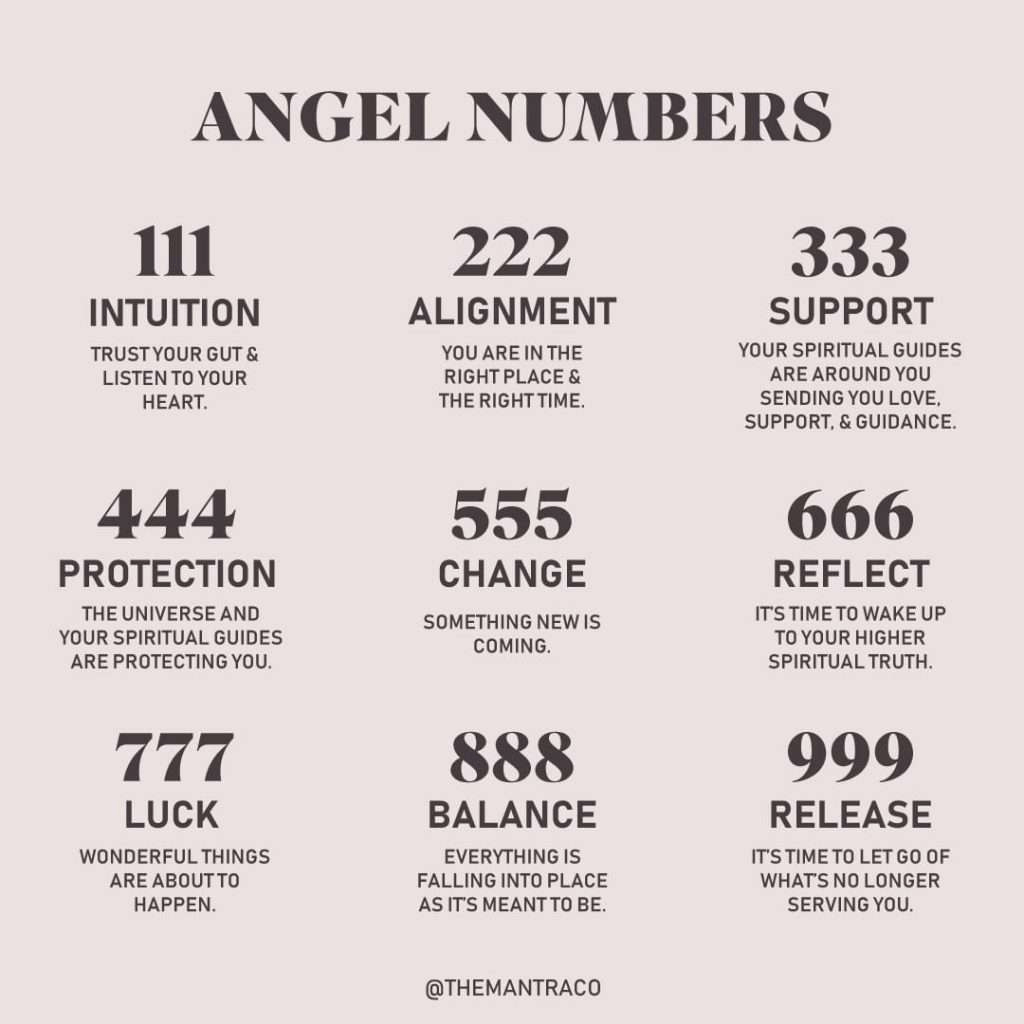
Recall the angel numbers discussed earlier, contained within the scriptures: 666 and 777.
During the post-exilic period, both Ezra and Nehemiah recorded the families who returned to Jerusalem from Babylon. The total number of each family are listed and in Ezra 2:13, ESV it says: ‘The sons of Adonikam, 666.’ Nehemiah on the other hand states 667 instead (Nehemiah 7:18), for this family who were part of the second wave of returnees.
Abarim Publications: ‘Ezra reports a secondary surge of Adonikamites returning with the second wave, and counts 63 males, among whom [are] Eliphelet, Jeuel and Shemaiah (Ezra 8:13).’ The name Jeuel is a family name of the tribe of Judah and his son, Zarah – 1 Chronicles 9:6.
The name Adonikam – only mentioned once in the Bible – according to Abarim means: ‘my Lord has risen’ or ‘Lord of enemies.’ From (1) the noun (adon), lord, and (2) the verb (qum), to rise up or stand.
There is a curious scripture where there is a fourth angel number listed.
1 Kings 10:14
English Standard Version
‘Now the weight of gold that came to Solomon in one year was 666 talents of gold…’
Aside from the similarity with the number of the Beast, this is an incredible amount of gold, just in one year. A talent is seventy-five pounds, which equates to 50,000 pounds or twenty-five tons. In today’s value this is worth a staggering, USD $1,728,890,625. Of interest perhaps is that Solomon’s name in numerology – albeit in English – looks like this:
1, [6], 3, [6], 4, [6], 5.
A further peculiar numerical coincidence involving Solomon is the fact he was born in the auspicious angel number year of 999 BCE. One could say it is 666 inverted.
The Untold Truth of King Solomon, Benito Cerino, 2020: ‘The Jewish Encyclopedia reports legend had it Solomon… could determine a person’s guilt simply by looking at them without need for a trial… Arguably, Solomon’s greatest achievement as king was the completion of the First Temple in Jerusalem… the Bible credits Solomon with planning, funding, and executing the construction of the Temple in order to create a permanent location for the Ark of the Covenant… the literal physical presence of God’ – refer article: The Ark of God.
Online Encylopaedia: ‘Solomon’s Temple is a central symbol of Freemasonry which holds that the first three Grand Masters were King Solomon, King Hiram I of Tyre, and Hiram Abiff – the craftsman/architect who built the temple. Masonic initiation rites include the reenactment of a scene set on the Temple Mount while it was under construction.’

‘Every Masonic lodge, therefore, is symbolically the Temple for the duration of the degree and possesses ritual objects representing the architecture of the Temple. These may either be built into the hall or be portable. Among the most prominent are replicas of the pillars Boaz and Jachin through which every initiate has to pass’ – refer articles: 33; The Establishment: Who are they… What do they want? and Chapter XXIII Aram & Tyre: Spain, Portugal & Brazil.
Occult World: Solomon knew ‘the lore of plants, animals, and everything in the natural world… [ruling] over the realm of nature… In legend, his wisdom expands to include formidable magical knowledge… [becoming] the greatest of magicians and his name is used to control both good and bad spirits… able to summon angels and command demons’ – 1 Kings 4:33.
‘Josephus’ Antiquities credits Solomon with writing 1,500 books of odes and songs and 3,000 books of parables and similitudes and knowing how to exorcize Demons’ – 1 Kings 4:32. ‘The Sefer Raziel, a magical text, says that Solomon was heir to the famed book (also called the Book of Mysteries), which enabled him to become the source of all wisdom.’
Historical Blindness: ‘… in the Wisdom of Solomon, and also in Jewish Antiquities, [Solomon] is depicted as a master of occult knowledge, and specifically two areas of knowledge: astronomy, which would further link him to the magical art of astrology, and demonic exorcism, which would contribute to the tales of his power to bend all spirits to his will.’
Occult World: ‘Numerous magical handbooks, or Grimoires, attributed to the authorship of Solomon were popular in the early centuries of Christianity. By the 12th century, at least 49 texts were in existence. The most famous was the Greater Key of Solomon, quoted often in the magical books of the 17th-19th centuries’ as well as the Lemegeton Clavicula Salomonis or Lesser Key of Solomon. Recall James Murrell the Cunning man, was in possession of The Key of Solomon. Other works attributed to Solomon include the Secrets of Solomon and The Book of Solomon.
Historical Blindness: ‘The various versions of the Keys of Solomon provide instructions for the practitioner of magic, directing them in purification rituals and how to prepare the tools they will require. They collect incantations like recipes, demonstrating how to cast spells that invoke rain, conjure gold coins, make oneself invisible, instill love, and curse enemies. And perhaps most offensive to the Church, they name and describe many demons and teach the magician how to summon them and how to compel them to do their bidding.’
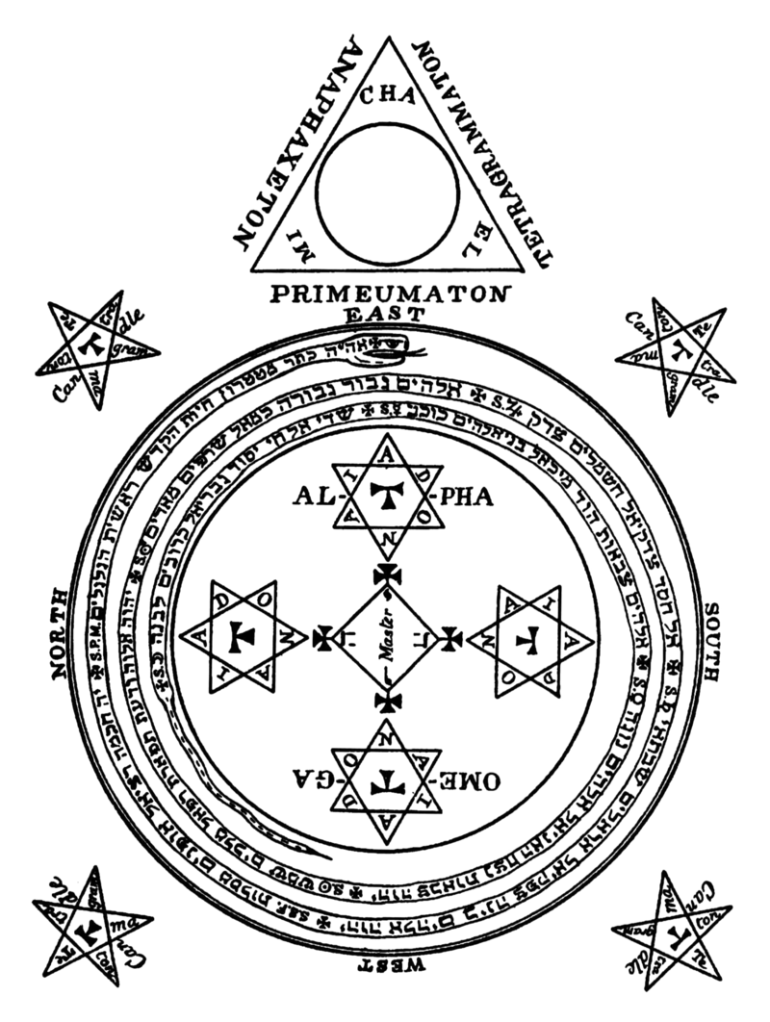
A magic circle used in the summoning of demons, according to the Lesser Key of Solomon
‘The question this begs is not why the [Catholic] church would ban such literature, but how the figure of Solomon, presented in the Bible as a wise and holy king favored by the Judeo-Christian God above all other men, came to be associated with black magic.
According to the lore of magic, King Solomon was not only a master magician, he was the originator of some magics. Just as Zoroaster is viewed as the first magus and inventor of astrology, and Hermes Trismegistus the first alchemist’ – refer article: Thoth – ‘King Solomon is thought of as the originator of more than one form of magic, such as Ars notoria, the magical art of supernaturally achieving knowledge, and perhaps most importantly, Ars goetia, the ritual magic used to summon and bind [72] demons and thus obtain favors from them.
… according to the magical myth of Solomon… God granted him supernatural wisdom like a superpower, including even the ability to talk with animals and to command spirits. From angels he received four magical stones, one that gave him power over the animal kingdom, one that empowered him to move heaven and earth, one that granted him dominion over all angels, and one that enabled him to bind even demons to his service… he united these stones into a ring that made him the most powerful human of all time. He possessed also the philosopher’s stone, it was believed by others, and thus was able to create gold and riches.
Zosimos… in one work refers to some supposedly ancient and conveniently lost book purportedly written by Solomon that is said to have detailed the many uses of quicksilver [or mercury – refer article: Thoth].
And with this great wealth and power, he built many wonders, forcing demons to complete the labor on his behalf. Not only did he build the Temple of Jerusalem in this manner, but also mythical constructions like the walled city of copper, a vast and secret city built to contain all his treasures and books of arcane wisdom.
In total, he was an ancient superhero, and his legend would provide the background for quite the adventure story. But where does this all come from? As mentioned, those who only know Solomon from the Bible know him only as the wise king, a writer of songs, lauded for his clever judgments, the builder of the First Temple, arrayed in riches and luxuries, and known for his sexual escapades. Unsurprisingly, there is no biblical basis for these fanciful legends, but perhaps more surprisingly, there is little scriptural support for any claims of Solomonic magic.’
Or, is there?
1 Kings 4:29-30, ESV: ‘And God gave Solomon wisdom and understanding beyond measure, and breadth of mind like the sand on the seashore, so that Solomon’s wisdom surpassed the wisdom of all the people of the east and all the wisdom of Egypt.’
Historic Blindness: ‘As Midrashic commentaries have emphasized, the wisdom of the East and Egypt was astrological in nature, so it would only make sense then that Solomon’s surpassing wisdom also partook of this kind of divination [‘the practice of attempting to foretell future events or discover hidden knowledge by occult or supernatural means’] and augury [the practice of divination].
The Hygromanteia is a Greek work, but portions of it appear to have Italian influence and to have been added later, in the early Middle Ages. In these sections, Solomon is not only a practitioner of astrology, but also of other forms of magic, such as hydromancy, the summoning of demons in a water basin to create a kind of crystal ball that would show him things he desired to see.
In the Arab and Muslim world… [Solomon] was called Nabi Sulayman and was said to be master of their version of demons, the djinn. Indeed, the entire notion of Solomon keeping demons in a bottle and forcing them to do his bidding may explain much about the development of stories featuring wish-granting genies kept in bottles.’
Allegedly, Solomon was in possession of magical items, including a flying carpet and was carried ‘aloft either by the demons at his command or by the winds that he could tame, depending on what source you read.’ Recall the rumours of James Murrell being able to move quickly from place to place as if he was transported by flying.
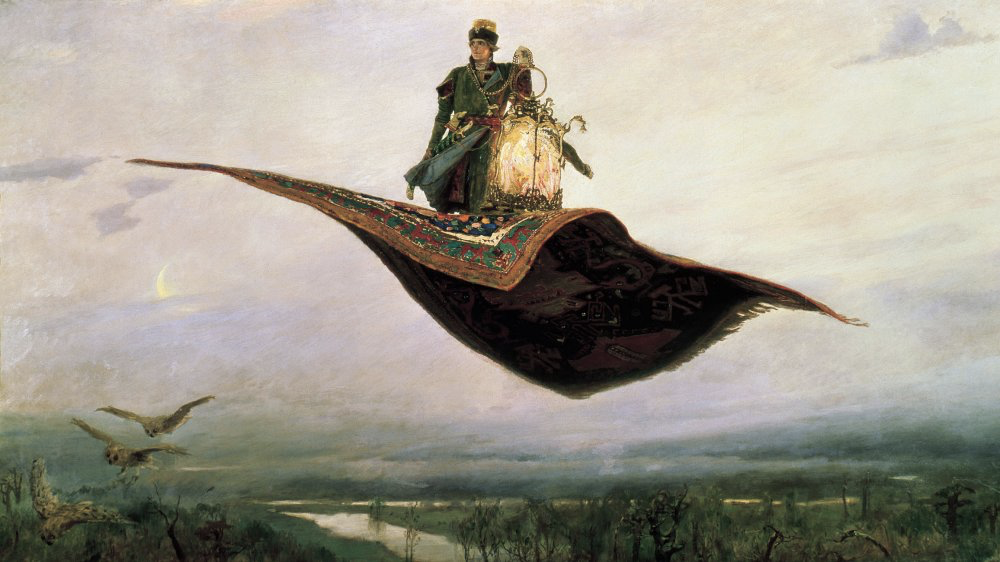
Cerino: ‘Of all of Solomon’s magic items that he used during his reign, probably the most famous is his ring that let him control demons. In many popular folktales of Solomon, this ring was known as the Seal of Solomon and featured a six-pointed [hexagram] Star of David on it, but in the early demonological text the Testament of Solomon, the ring is described as bearing a pentalpha, that is, a pentagram.’ The seal is the predecessor to the misleading name, the Star of David – a Jewish symbol – and in modern vexillology, it features on the flag of the state of Israel – refer Chapter XXIX Esau: The Thirteenth Tribe.
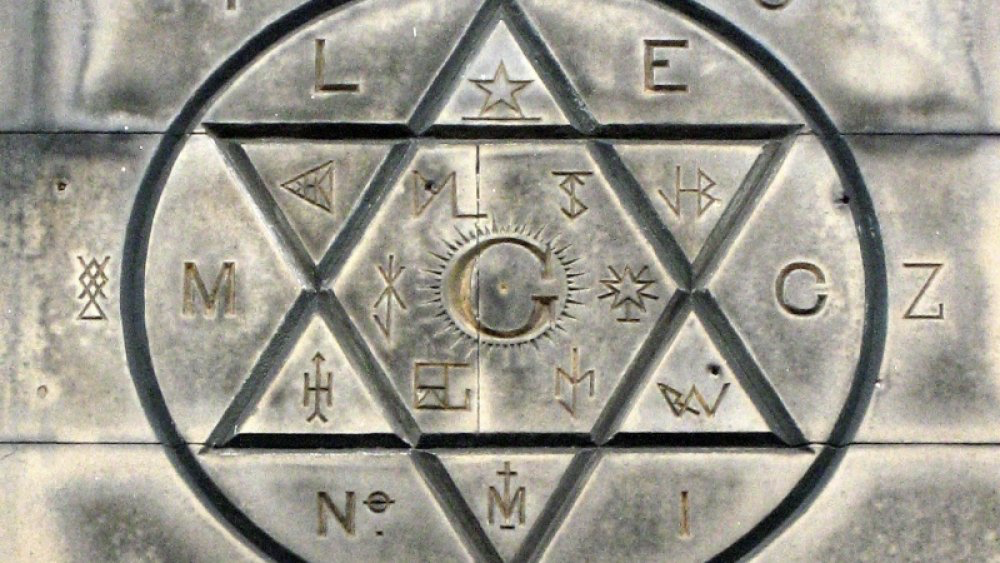
‘In that text, Solomon receives the ring from the archangel Michael… Once Solomon realizes his new power, he summons the demons one by one, learns their powers and dominions and to which constellations they are bound, as well as which angel has power over them. Once he has gained this wisdom, Solomon puts the demons to work on building the Temple.’
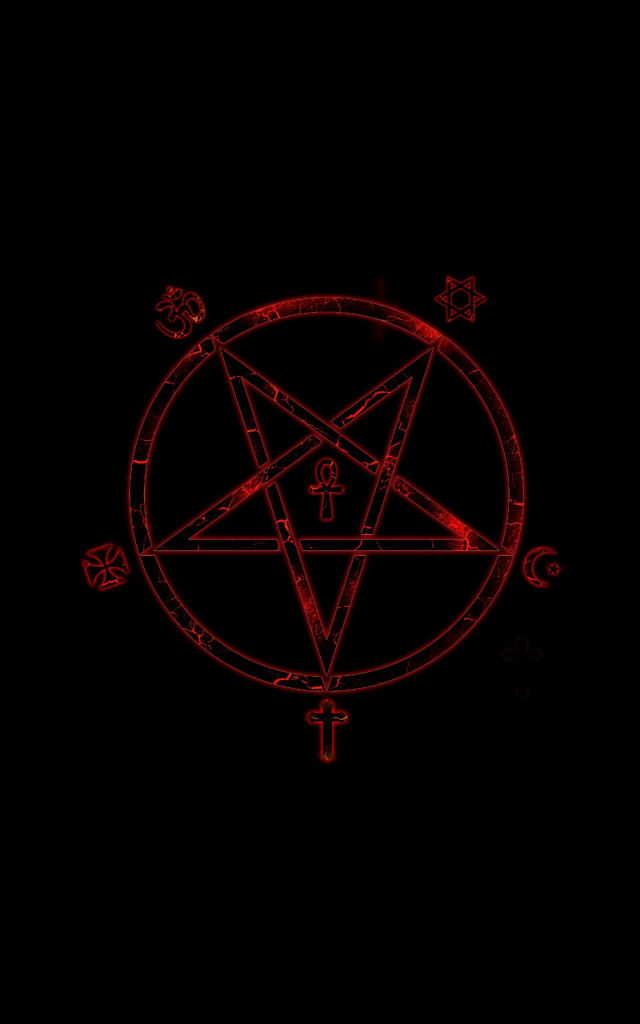
Occult World: ‘The Testament of Solomon… probably written between the first and third centuries C.E., is a legendary tale about how Solomon built the Temple of Jerusalem by commanding Demons. The text is rich in Demonology, angelology, and lore about medicine, astrology, and Magic. The author is unknown and may have been a Greek-speaking Christian who was familiar with the Babylonian Talmud. The magical lore related to Demons, which dominates the text, shows Babylonian influences.
The Demons are described as Fallen Angels or the offspring of fallen angels and human women, and they live in stars and constellations. They can shape shift into beasts and forces of nature. They lurk in deserts and haunt tombs, and they dedicate themselves to leading people astray. They are ruled by Beelzeboul (Beelzebub), the Prince of Demons.’

‘The stellar bodies themselves are Demonic, wielding destructive power over the affairs of humanity. The 36 decans, or 10-degree portions of the… 12 zodiacal signs, are called heavenly bodies and likewise are ruled by Demons, who cause mental and physical illnesses. There are seven “world rulers,” who are equated with the vices of deception, strife, fate, distress, error, power, and “the worst,” each of whom is thwarted by a particular angel (with the exception of “the worst”). Solomon summons them to appear before him for interrogation to learn what they do and the names of the angels who thwart them. They appear with heads of formless dogs and as humans, bulls, dragons with bird faces, beasts, and sphinxes.
The testament considers angels as God’s messengers but does not describe their origin or hierarchy. The main purpose of angels is to thwart Demons and render them powerless. Each angel is responsible for thwarting specific Demons. Humans must call upon the right angel by name in order to defeat a Demon; otherwise, Demons are worshipped as gods. Among the angels named are the archangels Michael, Raphael, Gabriel, and Uriel’ – Chapter XXII Alpha & Omega.
‘When the Demon ORNIAS vampirizes Solomon’s favourite boy by sucking out his soul through his thumb, Solomon begs God for power over the Demon. While he prays, Michael appears and gives Solomon a ring with a seal engraved upon a precious stone. Michael tells Solomon that this magical ring will give him power over all Demons, male and female, and that they will help him build the temple. The Demons are subdued when the ring is thrown at their chests with the command “Solomon summons you!” Solomon interviews the Demons and demands from them the names of their thwarting angels. When they are subdued, they are made to construct his temple. One of [the] Demons interrogated by Solomon gives no name but describes himself as “a lecherous spirit of a giant man who died in a massacre in the age of giants.” He lives in “inaccessible places” – Articles: Nephilim & Elioud Giants I & II.
Historical Blindness: ‘Josephus included in his Jewish Antiquities an account of an exorcism performed by a man named Eleazar who cast out demons in the name of Solomon, speaking incantations the text says were written by Solomon, and pressing a ring said to bear the seal of Solomon to the possessed man’s nose.
Clearly by this point, the exorcism rituals attributed to Solomon had become a kind of folk healing remedy, and his name and seal an apotropaic [‘intended to ward off evil’] protection against evil spirits. Interestingly, we see here a ring, though not the magical ring gifted by angels to endow Solomon with power over all things. Rather it seems perhaps many such rings may have been made and used in such rituals, their power thought to derive from the “seal” engraved on it.
Over the following centuries, many apotropaic amulets would be inscribed with the names of demons, following the Solomonic exorcism ritual, and would even claim to bear the seal given to Solomon to ward off demons. Sometime after the first century CE, likely in the period of Late Antiquity between the 3rd and 6th centuries, we find this legend fully formed in the fragments later collected in the Middle Ages as the pseudepigraphal work called the Testament of Solomon, which not only has him wielding his magic ring but also compiles an entire demonology, with the names of each offending spirit, the nature of their activities, and specific prescriptions for exorcising them.’
Most if not all of the works ascribed to Solomon outside of the Bible, are likely not written by him, but rather an example of authors who have attributed their work to a more famous, well-known person to give their text legitimacy and credibility. Even so, “where there is smoke there is fire.” Solomon’s descent along the left hand path is undeniable and therefore his interaction with evil spirits a given. He followed many of the beliefs of his seven hundred wives and three hundred concubines, which ultimately led to his sickeningly sacrificing hundreds of his own children – refer Chapter XIII India & Pakistan: Cush & Phut; and article: Na’amah.
Whatever predisposition towards spirituality Solomon may have inherited as a seventh son of a very potent seventh son in his own right, King David, it was not used for the benefit of others; whether it included any gifts of healing and divination or not, but for selfish satisfaction.
1 Kings 11:6-10
English Standard Version
‘… Solomon did what was evil in the sight of the Lord and did not wholly follow the Lord, as David his father had done… Solomon built a high place for Chemosh the abomination of Moab, and for Molech the abomination of the Ammonites, on the mountain east of Jerusalem’ – Articles: Na’amah; and Belphegor. ‘And so he did for all his foreign wives, who made offerings and sacrificed to their gods. And the Lord was angry with Solomon, because his heart had turned away from the Lord, the God of Israel, who had appeared to him twice and had commanded him… that he should not go after other gods. But he did not keep what the Lord commanded.’
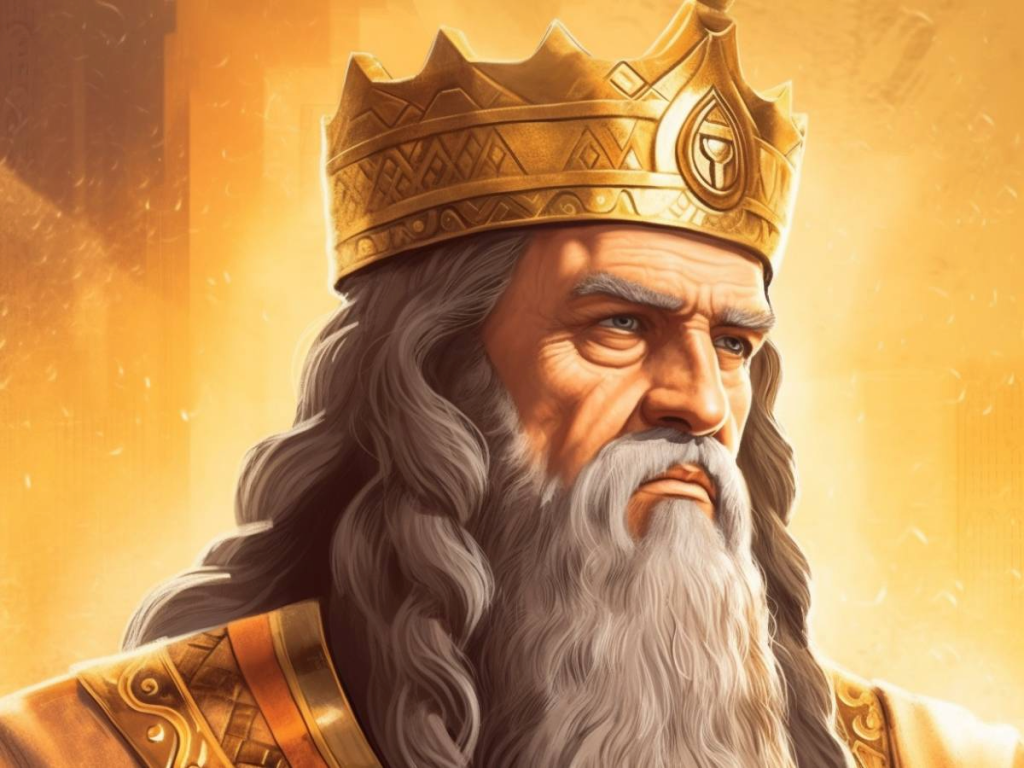
The most famous seventh son of a seventh son of all – hidden in plain sight within the inspired pages of the Bible – tragically failed to live up to his incredible potential and instead became entangled in demonolatry; plummeting into the dark depths where the daemons themselves reside.
Jesus said to them, “… I have given you power to crush… snakes and scorpions under your feet. Nothing will hurt you. Yes, even the spirits obey you. And you can be happy, not because you have this power, but because your names are written in heaven.”
Luke 10:18-20 Easy-to-Read Version
Now the priest of Midian had seven daughters, and they came and drew water and filled the troughs to water their father’s flock.
Exodus 2:16 English Standard Version
“I’m not quite sure what the odds are of a seventh son of a seventh son, however it must have happened by now because I am the seventh daughter of the seventh daughter of the seventh daughter. As I understand it, the odds are astronomical, but here I am, so I’m certain that such a man exists!”
Win Strack
© Orion Gold 2024 – All rights reserved. Permission to copy, use or distribute, if acknowledgement of the original authorship is attributed to orion-gold.com
